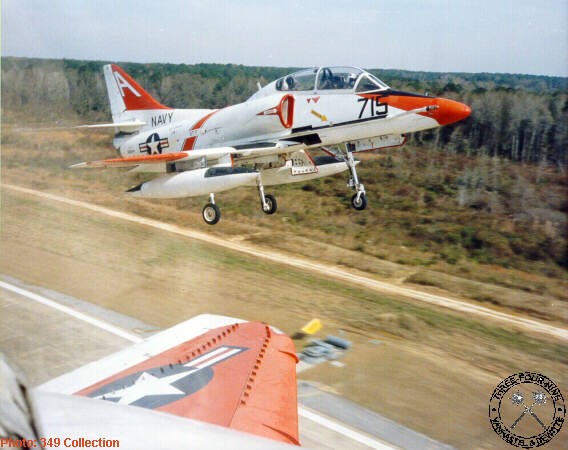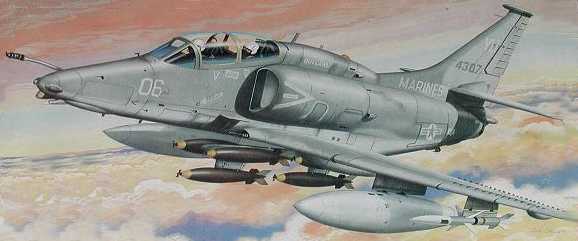
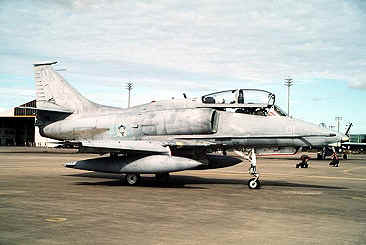


www.airpower.maxwell.af.mil/airchronicles/cc/pustam.html
the author, Anil R. Pustam points out that:
"Both the A-10 and Su-25/39 are single-seat aircraft. A two-place machine is an option that could be further studied. The CAS regime includes flight at low-level, negotiating ground based threats, and in mountainous areas, weaving amongst valleys and cloud-obscured peaks while looking for and attacking small, camouflaged, mobile targets. Having a second crewmember aboard would allow the pilot to concentrate on the flying while he performs other duties."
Yet the USAF refuses to up-engine, re-wing and make its A-10s into two-seaters to do CAS more effectively. They are obsessed with slapping in electrogadgets into physically decaying platforms until such time they can buy incredibly expensive new "cash cow" platforms in lesser and lesser quantities. Chuck Spinney's "Death Spiral" lives.
Again in the same National Defense magazine below in an article by Harold Kennedy, we see the same Tofflerian/RMA disease in action. On on side of the USAF's mouth you will see them praise the PHYSICAL armor protection and STOL capabilities of the A-10 AFTERRRRRRRRRRRR they first gloat over precision guidance as a panacea inline with their Tofflerian/"RMA Jesus" crap religion they believe in. Nevermind it was another generation of USAF reformers that had to fight tooth and nail to get the A-10 physical platform into existence. The hypocrisy is that if the same people in charge of the USAF today if they were in charge in the 1970s there wouldn't have been an A-10. The current USAF leadership's continual physical neglect of the A-10 so as to kill it as soon as possible reveals their true outlook.
Then notice that they don't rewing the A-10s, put new engines in or add a second seat crewman to act as an enlisted JTAC observer these are PHYSICAL THINGS that would keep what would be the OA-10B flying for more years to come. They don't want that.
They want F-35 STOVL which we do praise for its STOL operational capabilities, BUT WE ALREADY HAVE STOL IN THE A-10. And to be able to STOVL the F-35 IS NOT ARMORED to do CAS/MAS effectively, it will be another easy-to-shoot-down Harrier if it goes low and slow. Even if you slap armor onto it just like the Army does to try to make Humvee trucks into combat vehicles instead of using actual combat capable tracks lest they look like "mech pussies" which they are not, the F-35 JSF lacks the aerodynamics to fly low and with agility to do CAS/MAS.
We WERE glad the USAF WAS GOING TO buy some F-35 STOVLs to get out of the habit of using vulnerable, fixed, air bases. They reneged on this capabilities improvement. They really don't want ANY F-35s and would love to back out of the program entirely to collapse it and destroy their rivals in the USN/Mc forever who have banked THE ENTIRE FUTURE OF NAVAL AVIATION ON THE JSF. But we think its also high time the U.S. Army get a fixed-wing MAS/AFAC aircraft to COMPLIMENT the non-sense the USAF is doing ie; when it doesn't work Army troops don't get caught in the lurch.
www.nationaldefensemagazine.org/article.cfm?Id=1498
July 2004Air Force Seeks to Upgrade Close Air Support Fleet
by Harold Kennedy
As the Iraqi and Afghan conflicts evolve essentially into ground wars-with U.S. and coalition infantry units fighting small bands of guerrilla fighters-the Air Force is moving to improve its ability to provide close air support, according to the service's top officials.
The Air Force is developing new tactics, equipment and organizational structures to conduct CAS operations. The aging A/OA-10 Thunderbolt II-the first Air Force aircraft designed especially for close air support-is getting upgraded precision-strike technology. The aircraft comes in two versions. The A-10 actually attacks enemy ground troops, while the OA-10 variant performs airborne forward air control.
To replace the A/OA-10 in future CAS missions, the service has decided to acquire the short-takeoff, vertical-landing version of the F-35 Joint Strike Fighter, which is still under development.
In 2003, Air Force aircraft flew more than 10,000 CAS sorties in Iraq and Afghanistan the two countries. The effectiveness of those CAS missions "was unprecedented," said Lt. Gen. William S. Wallace, former chief of the U.S. Army V Corps. "None of my commanders complained about [its] availability, responsiveness or effectiveness."
CAS was a key factor in the rapid destruction of enemy ground forces in both wars, U.S. military leaders said. Thirty days after operations began in Afghanistan in 2001, U.S. and coalition troops were able to enter Kabul, and within 26 days of fighting in Iraq, they captured the last major Iraqi city, Gen. Michael Moseley, Air Force vice chief of staff, told the House Armed Services Committee.
In the battle for Baghdad, U.S. military officials put together an innovative, complex plan for urban CAS, Moseley said. Airborne forward air controllers flew over the city 24 hours a day, assigning missions to multiple sets of fighter aircraft stacked up in the air nearby.
In the stack was a mix of Air Force, Navy and marine fighters, including A/OA-10s, F-15 Eagles, F-16 Fighting Falcons, F-14 Tomcats [EDITOR: not anymore, F-14s are retired] and F-18 Hornets.
Under this scenario, a ground commander receiving CAS "may be working with a marine in an F-18 or Navy crew in an F-14 [not anymore status quo apologent] or an Air Force pilot in an A-10," Moseley said. "You won't know the difference. You'll just know the call sign and the location."
In addition to fighters, CAS is provided by AH-64 Apache and AH-1W Cobra helicopters and AC-130 gunships. With the development of precision-guided munitions, long-range bombers-B-1 Lancers, B-2 Spirits and B-52 Stratofortresses-are conducting CAS missions from high above the battlefield. "CAS from 40,000 feet is truly transformational," Roche said.
Even RQ-1 Predator unmanned aerial vehicles, armed with Hellfire laser-guided missiles, are flying CAS missions.
When CAS is needed, the troops on the ground don't care which aircraft provides it, said Air Force Capt. Dan King, who flies an F-15E for the 336th Fighter Squadron, headquartered at Seymour Johnson Air Force Base, N.C.
[EDITOR: SAYS WHO? THE F-15 DRIVER DESPERATE FOR A MISSION? WE THE GRUNTS DON'T WANT PLANES THAT FLY TOO FAST DROPPING BOMBS ON US, ARE WE QUOTED IN THIS ARTICLE?]
King, who spoke to National Defense at the 2004 Joint Service Open House at Andrews Air Force Base, Md., has seen CAS from a number of perspectives. He has flown CAS missions in the F-15 and the A/O-10 during the current conflict, and he served as an enlisted man in the Army's 82nd Airborne Division during the first Persian Gulf War.
"When you're being shot at, it's not what kind of aircraft they are," he said. "It's how fast can they get here. A minute is an eternity."
[EDITOR: and USAF centralized-control, fuel-hungry fighter jets that cannot fly constantly overhead but are hundreds of miles away at a safe "rear" airbase with long hard runways is going to get there quickly?]
Army Sgt. Scott Bates, of the 3rd Battalion, 75th Ranger Regiment, agreed. His unit called in CAS in April 2003, when it came under fire after seizing the Hadithah Dam, which is located on Iraq's Euphrates River. "I don't know what kind of aircraft they were, but they came in, one after the other, and dropped ordnance pretty close," he said. "They were on target and very effective."
[EDITOR: "I don't know what kind they were?" What a dumbass. What if they were ENEMY aircraft? Would you know the differance or would you have to wait til napalm flames are covering your body to realize you are under attack? Maybe if you spent less time in the mirror in the gym admiring yourself each day and more time studying aircraft identification pictures you'd know?]
Picking the right target, however, can be difficult. In May, for example, coalition forces, operating near Iraq's border with Syria, said they came under hostile fire and called in CAS, killing perhaps 40 people.
[EDITOR: which creates MORE REBELS. Using the wrong airplane flying too fast without a back-seat observer, what do you expect?]
Coalition officials said the dead were foreign terrorists. But Iraqis claimed that they were members of a wedding party, where weapons had been fired into the air as part of the celebrations. The incident is under investigation.
In 2001, three U.S. servicemen and five Afghan allies died when a B-52 dropped a 2,000-pound Joint Direct Attack Munition about 100 meters from their position north of Kandahar. The U.S. troops had called for strikes on enemy forces near their own position.
In 2002, two U.S. F-16 pilots in Afghanistan attacked a Canadian army unit that was conducting live-fire training, killing four. The two pilots were slapped with criminal charges, including manslaughter, assault and failing to exercise appropriate flight discipline and not complying with the rules of engagement. One pilot has resigned from the service. The other's court martial is pending.
The Air Force is taking a number of steps to minimize incidents of fratricide and otherwise improve CAS operations.
[EDITOR: are they putting a back-seat observer into the A-10? Then they can shut up. They are liars playing at doing CAS and wanting to do bogus DAS].
In 2001, the service awarded a $226 million contract to Lockheed Martin Systems Integration, of Owego, N.Y., calling for the firm to act as the prime contractor in a major upgrade of the A/OA-10.
The contract calls for Lockheed's Aerospace Systems unit to design, manufacture and test an enhanced precision-engagement system, explained Roger Il Grande, Lockheed's A/OA-10 program manager. This involves installing a digital stores management system for improved cockpit control of weapons systems, new cockpit displays, a Situational Data Link to provide more accurate information about friendly forces and potential enemy threats, a direct-current generator upgrade, guided weapons, such as the JDAM and Wind-Corrected Munitions Dispenser, and an advanced targeting pod.
[EDITOR: more mental distractions for a pilot trying to avoid flying into the ground when what he needs is a back-seat observer handling this stuff]
Lockheed's Sniper XR Advanced Targeting Pod is a precision targeting system. It incorporates a high-resolution, mid-wave, third-generation forward-looking infrared; a dual-mode laser and a charged, coupled-device sensor, along with a laser spot tracker, a laser marker and a sophisticated data link. These technologies enable the Sniper XR to detect, classify and engage targets at more than three times the distance of older pods, Il Grande said.
Lockheed plans to begin flight tests of the new system in September of this year, and to have it installed on all A/OA-10s by the first quarter of 2009, he said.
At the Hill Air Force Base, Utah, meanwhile, Ogden Air Logistics Center is embarked upon a "Hog-up" program, which is designed to extend the lifespan of the A/OA-10-nicknamed the "Warthog" for its ungainly appearance-from 4,000 hours of air operations to 16,000. Most of the work, officials said, involves refurbishing the center part of the wing, which absorbs much of the stresses of flying.
The Air Force currently has 357 A/O-10s in its inventory. The service has been flying them since 1975, and maintenance costs are rising, Roche said. For this reason, he said, the Air Force is planning to retire some of them-the exact number is still being determined-and plow the savings into upgrades for the remainder of the fleet.
The reason: "The A/0A-10 may be an old plane, but it has characteristics that make it lethal on the battlefield," said a spokesman for Checkmate, the Air Force's secretive operational planning and analysis cell, located in the basement of the Pentagon.
The twin-engine A/OA-10 can prowl over the battlefield at 420 mph-a quarter of the top speed of an F-15, he explained. A 30mm GAU-8/A seven-barrel Gatling gun juts from its nose, firing 3,900 rounds a minute and destroying an array of ground targets, including tanks. Under its wings and fuselage, it carries up to 16,000 pounds of mixed ordnance, including laser-guided munitions, incendiary cluster bombs, and AGM-65 Maverick and AIM-9 Sidewinder missiles.
Flying as low as 100 feet above the fighting, the Warthog makes an attractive target for enemy fire, but the pilot and part of the flight-control system are protected by titanium armor. Redundant primary structural sections help the aircraft survive enemy fire. The aircraft can survive direct hits from armor-piercing and high-explosive projectiles up to 23mm in size.
The Air Force intends to replace the A/OA-10 with the STOVL version of the F-35, officials said. The F-35 is being designed in three versions, one that operates from conventional airfields, one that can take off and land on Navy aircraft carriers, and one that can take off from short, austere landing strips and land vertically on amphibious warships.
The Air Force originally planned to buy the conventional variant of the aircraft, and it still plans to do so. It has decided, however, that the short-takeoff model-originally designed for the marines-fits in better with the CAS mission.
"We're not interested, as the marine corps is, in the vertical part of it," Air Force Chief of Staff Gen. John P. Jumper told a recent conference sponsored by the National Defense Industrial Association. "We're interested in the short-field capabilities, [which] will open up thousands more airfields around the world for us."
The design of the F-35's airframe, however, "is taking longer and is more complex than had been originally anticipated," John J. Young Jr., assistant secretary of the Navy for research, development and acquisition, recently told the House Armed Services Committee.
"Additional design work is required to address technical issues, primarily weight projections," Young said. The result will be cost increases and delays, he said, explaining that low-rate initial production is scheduled now to start in fiscal year 2007, instead of 2006.
These problems, however, are "solvable within the normal parameters of design fluctuation," Young argued. "We are re-planning JSF system development and demonstration to make sure that we succeed."
The Air Force also is seeking to make better use of its "battlefield airmen"-the combat controllers, para-rescue specialists, combat weather technicians, special tactics teams and tactical air control parties, who deploy with ground forces to help coordinate CAS missions-Roche said.
"Just as we have a family of airmen we call 'pilots,' with a variety of specialties-helicopter, fighter, tanker, airlift, bomber-we need to start thinking about these specialized warriors, these battlefield airmen, in similar terms," he said. "We need to consolidate our battlefield airmen ... under a common organizational and training structure, and strengthen the combat power they bring to the battlefield, whether it be in Air Combat Command or in Air Force Special Operations."
The ACC, headquartered at Langley Air Force Base, Va., is leading an effort to define more clearly how the Air Force should use "the guys at the pointy end of the sortie," said Chief Master Sgt. Michael Breeden, from the Special Operations Division of the Air Staff at the Pentagon. An ACC team is developing plans for a more coherent organizational structure, training and equipment, he said.
Some changes already are underway. In October 2003, the service transferred nearly 7,000 combat search and rescue personnel to AFSOC. Air commandos have worked, for many years, side-by-side with CSAR specialists, said the AFSOC commander, Lt. Gen. Paul Hester. Placing them in one organization will strengthen their ability to perform missions, he said.
"Although only CSAR units based in the continental United States will realign, our objective is to improve the mission, training, equipment and career opportunities for the entire Air Force CSAR community," Hester said.
To lighten the load that these various specialists must take into combat with them, the Air Force has begun deploying a new battlefield air-operations kit that is 50 percent lighter than traditional versions.
The old kits weighed as much as 160 pounds, and included outdated mapping, plotting, designation and communications equipment, Roche said. In addition to being lighter, the new equipment reduces the time it takes to link sensors to shooters by 40 percent.
CAS by expensive guided munitions is really DISTANT Air Support (DAS), which is really support-from-a-distance (SAD) what we need today is MANEUVER Air Support (MAS)
Despite from the continual string of lies emanating from the status quo DoD, things ARE NOT GOING WELL OVERSEAS FOR U.S. TROOPS. The robotic plane UAV cannot see anywhere near as well as human Air Forward Air Control (AFAC) observers can from observation/attack planes and steering expensive guided munitions by ground observers from sexy fast jets or heavy bombers is really DISTANT air support (DAS) or "support-from-a-distance (SAD) of a dubious value. The enemy using C3D2 is effectively hiding from us because we lack a 24/7/365 continuous overhead presence (COOP) over the battlefield that denies him freedom of action to do things like lay roadside bombs what we call "maneuver air support" (MAS).
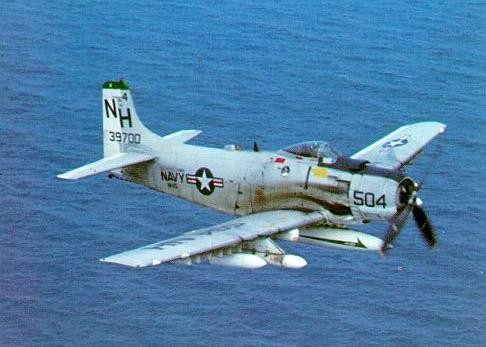
Bird Dogs gone by 1970...
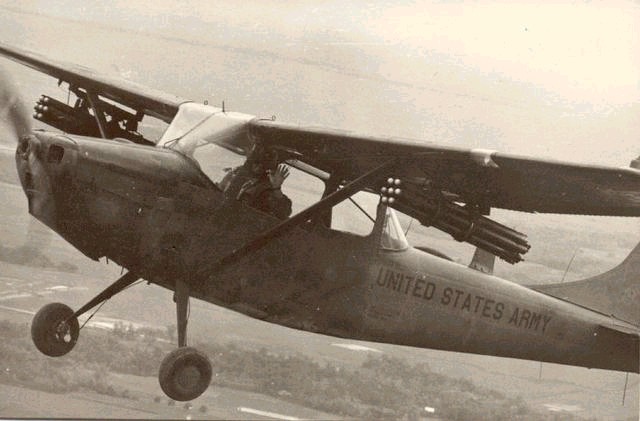
Dragonflies: gone by 1983
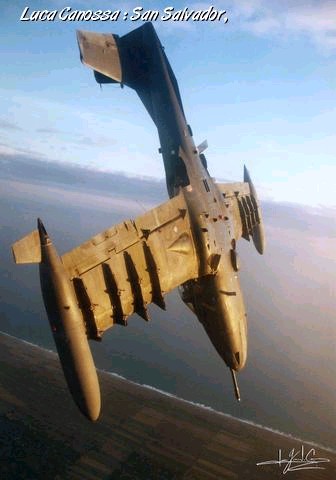
Broncos: gone by 1994...
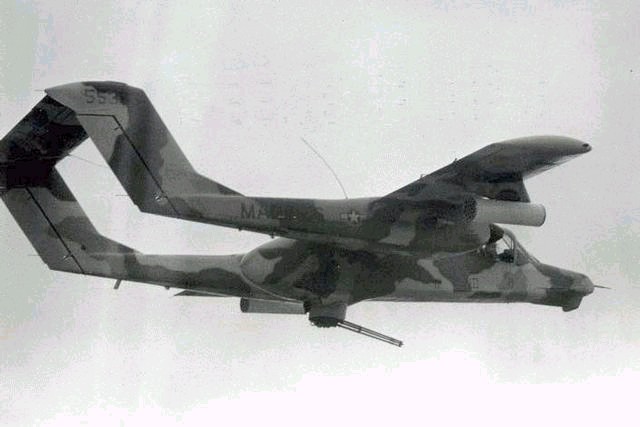
Mohawks: gone by 1996...
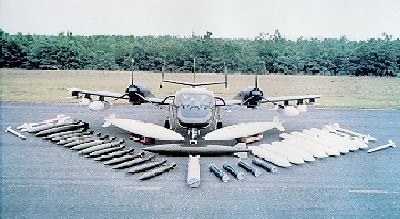
The last time we had observation/attack aircraft capable of providing MAS was 1996 with the OV-1 Mohawk. Two years before we lost the OV-10 Bronco. And in 1972 the USAF and in 1968 the USN retired their A-1 SkyRaiders. The USAF operated fabulous A-37 Dragonflies as CAS and AFAC OA-37s until saying the A-10 replaced them in 1983---which makes no sense since the latter does not have a seat for an observer! The hypocritical USMC claims it "invented CAS" in the 1920s which is hard to swallow since CAS was done all during WW1 from 1914 to 1918, but ditched their SkyRaiders in 1959!
Both Army and marine aviation has been led astray by narcissistic egomaniacs who want to either fly too slow in loud and vulnerable helicopters (rotor-heads)or too fast to see the enemy below on the ground (Jet Jocks). The centalizing of all aircraft is the core USAF mental illness resulting from the 1943 North African escapade where the flyboys didn't get to strafe the other guy's airfields because ground commanders had them providing CAS. Since that time the USAF egomaniac has pontificated that he can do anti-air, interdiction and CAS all from the same sexy fast fighter-bomber and it simply doesn't work, the CAS mission requires a slower, agile and armored plane that the jet jock doesn't want to fly and his imbecilic weak ego will not allow anyone else to fly these type planes lest he not be the center of attention. To try to work around all of them and not need an egomaniac-in-the-cockpit, we've turned to unmanned model planes with fixed wings and props but they do not see the ground well enough relaying imagery through a soda straw to discover the elusive enemy aware of the "American (Lazy) Way of War" using aircraft firepower bombardment ever since the Korean War in 1950. Army Aviation is particularly at fault for no longer flying fixed-wing o/a aircraft for it created the STOL observation grasshopper capability in the first place in the 1930s then gave up the ghost in retiring its O-1 Bird Dogs in the early 1970s after they had served so well in Vietnam.
Adding to the narcissism is a general lack of seeing reality clearly. There is always a battle against the earth (TBATE) underway in military operations. If your aircraft flies too fast it will not see the enemy below and if its too complicated it may simply be grounded due to needing repairs and parts. The U.S. military populated by weak egomaniacs ignore TBATE and jump to the battle against man (TBAM) and focus in on the feel-good human enemies that mirror themselves and what they want to do, which is fly things that stroke their egos, either too slow or too fast.
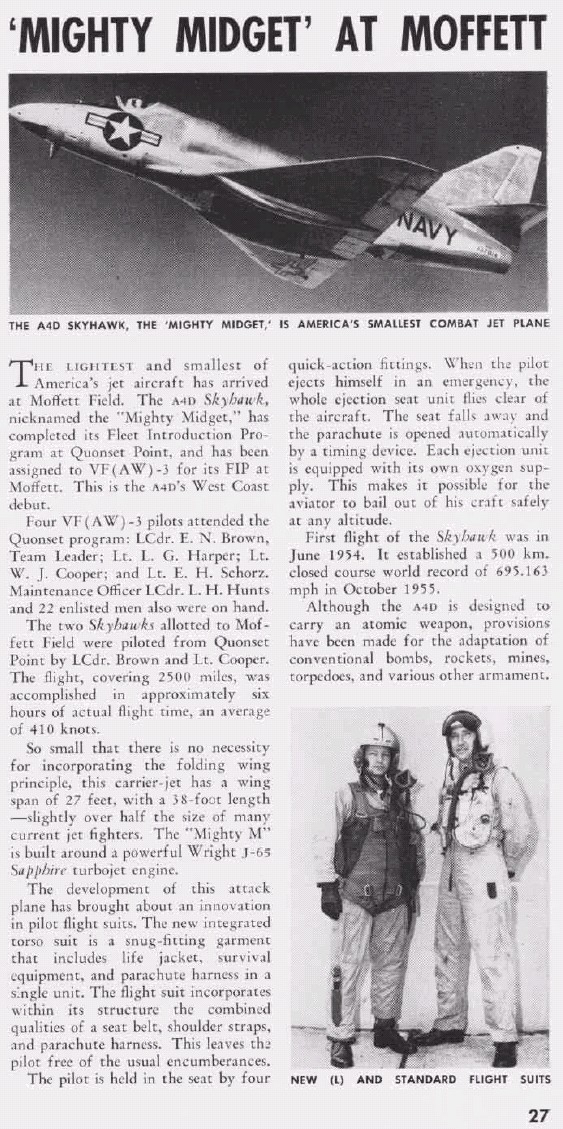
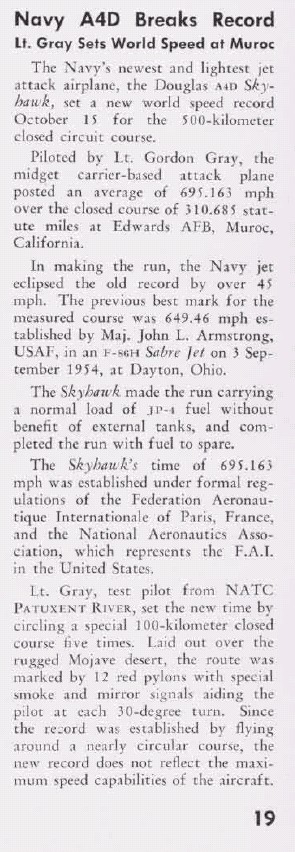
Ignoring TBATE, in the 1950s, the 300 mph SkyRaider was thought to be replaceable by the 650 mph A-4 SkyRaider because it was a sexy jet and could fly faster and higher.
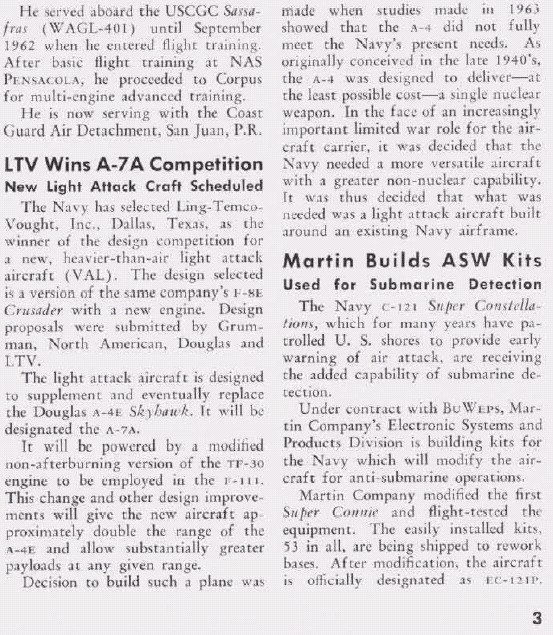
Then in the 1960s, the A-4 was replaced by the subsonic version of the F-8 Crusader called the A-7 Corsair II because it was touted as being twice the size and could carry twice the ordnance for twice the range, then absurdly by the A-6 Intruder which could go allegedly twice as far and carry twice as much as it in "ALL WEATHER" though in actual practice, severe bad weather grounds all airplanes. All of them are subsonic, so the F-18 comes along to allegedly replace the F-4 Phantom and the "A" series attack planes even though once its carrying bombs its subsonic, too. When a MACH 1.8 F-18 unloads its bombs its not anywhere near as fast as the MACH 2+ Phantom but we are supposed to assume this is "progress". This wouldn't be necessary if the SkyHawk was close to the places where ground troops were fighting the enemy and could fly more sorties using its carrier landing gear to be catapulted into the air and arrested by a tail-hook and wires.
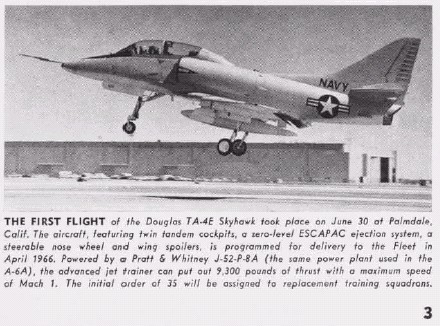
The two-seat A-4 didn't arrive until 1965, but was quickly put to use an an AFAC using the rear seat observer which could be somewhat effective as the two-seat F-100F "Misty Facs" were over North Vietnam.
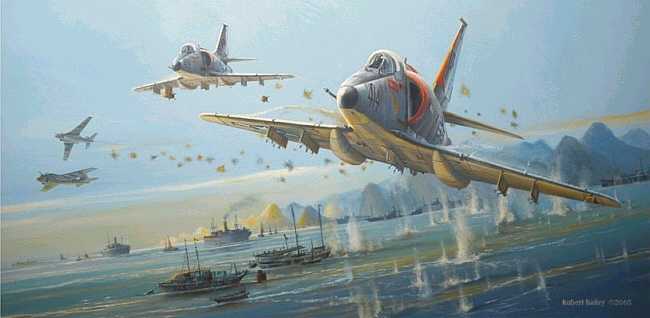
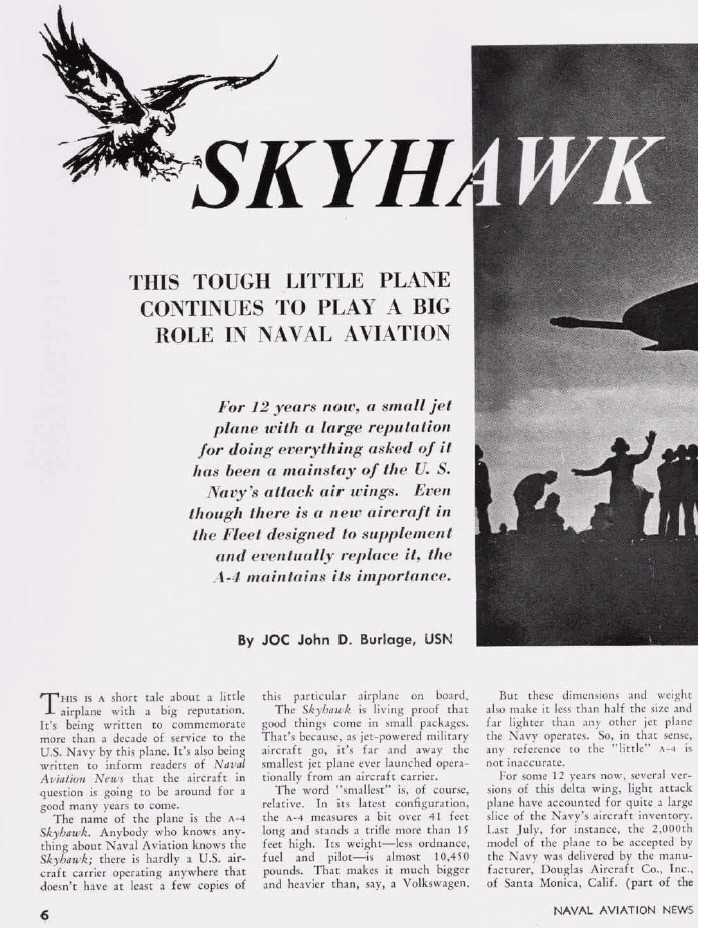
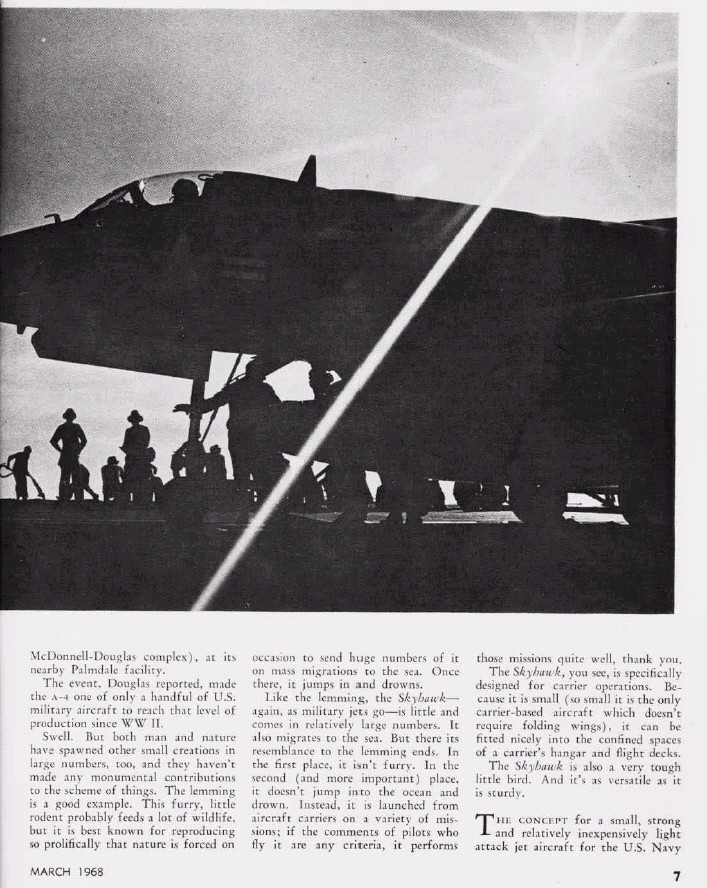
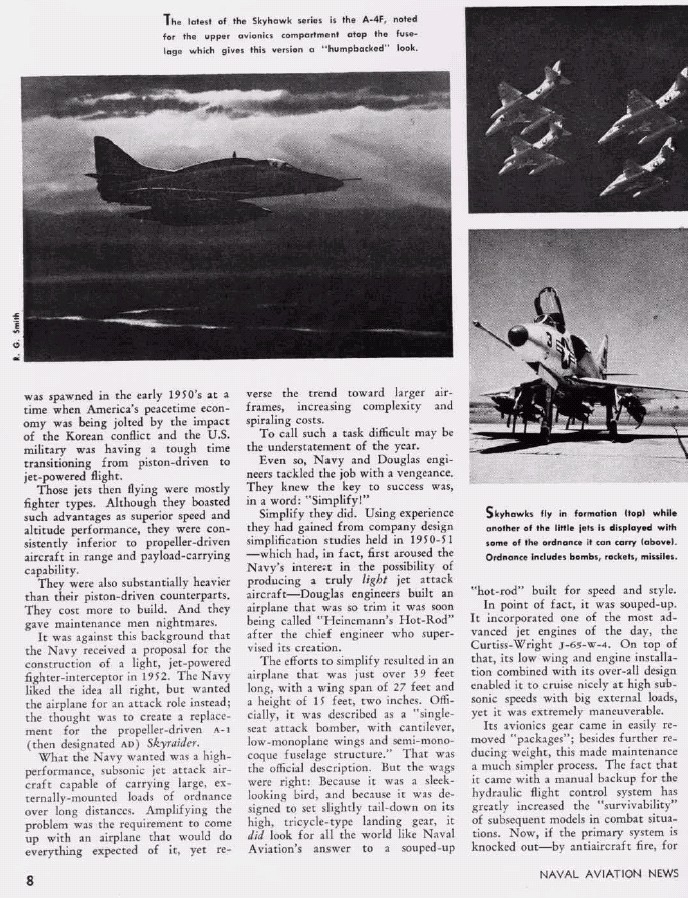
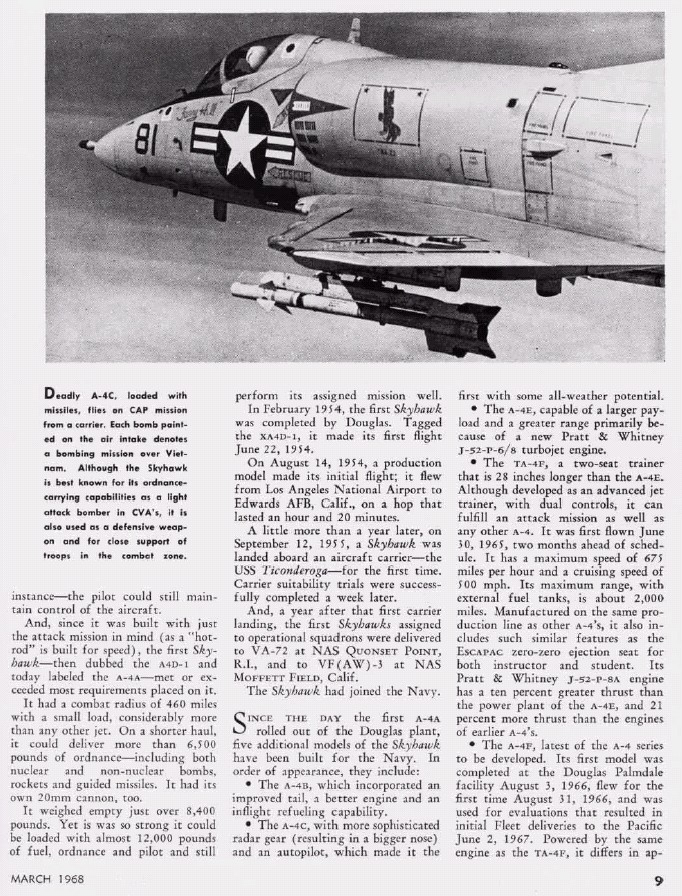
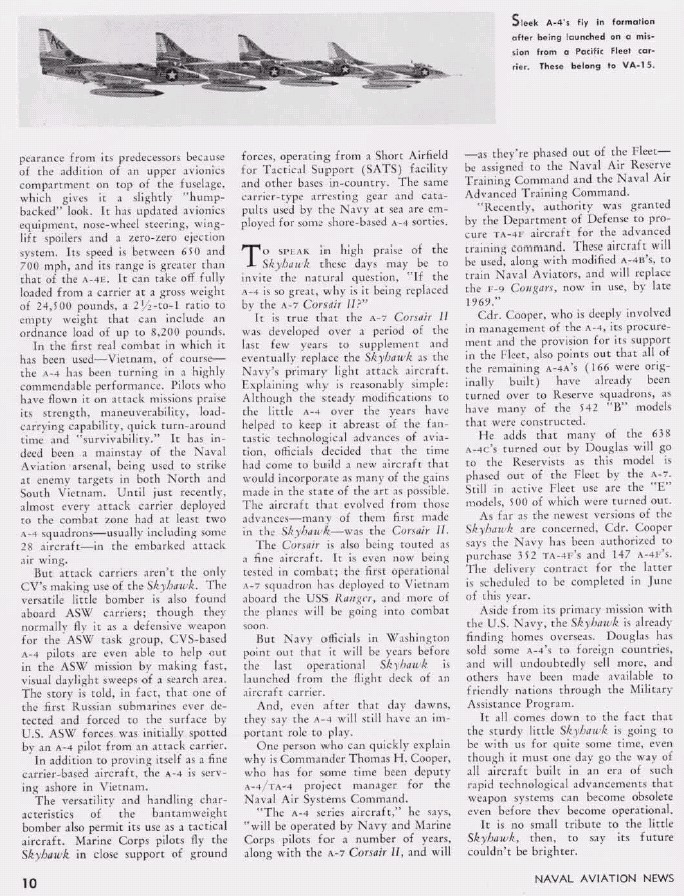
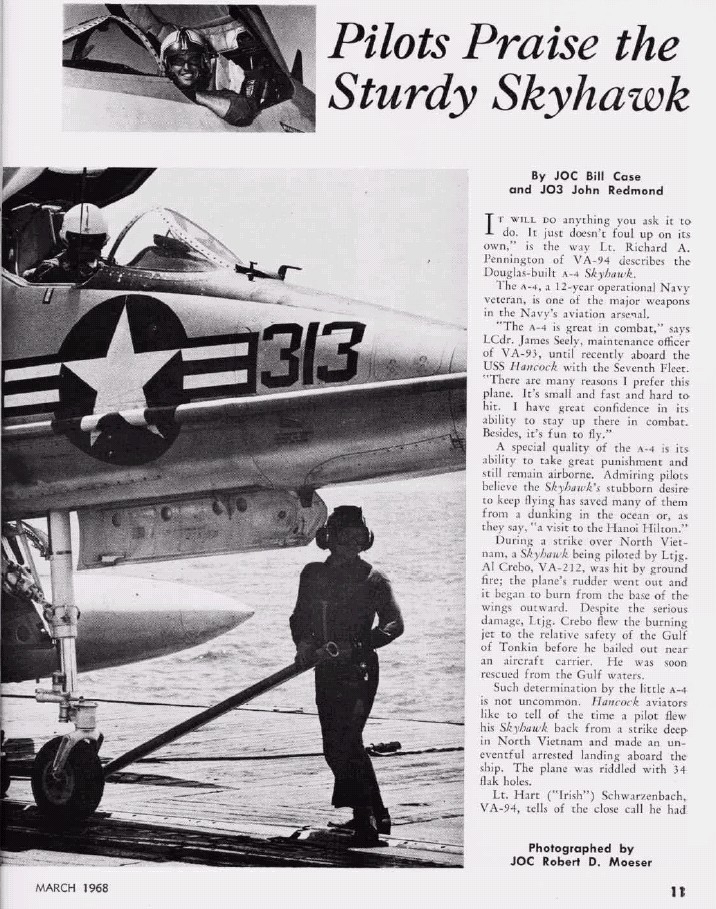
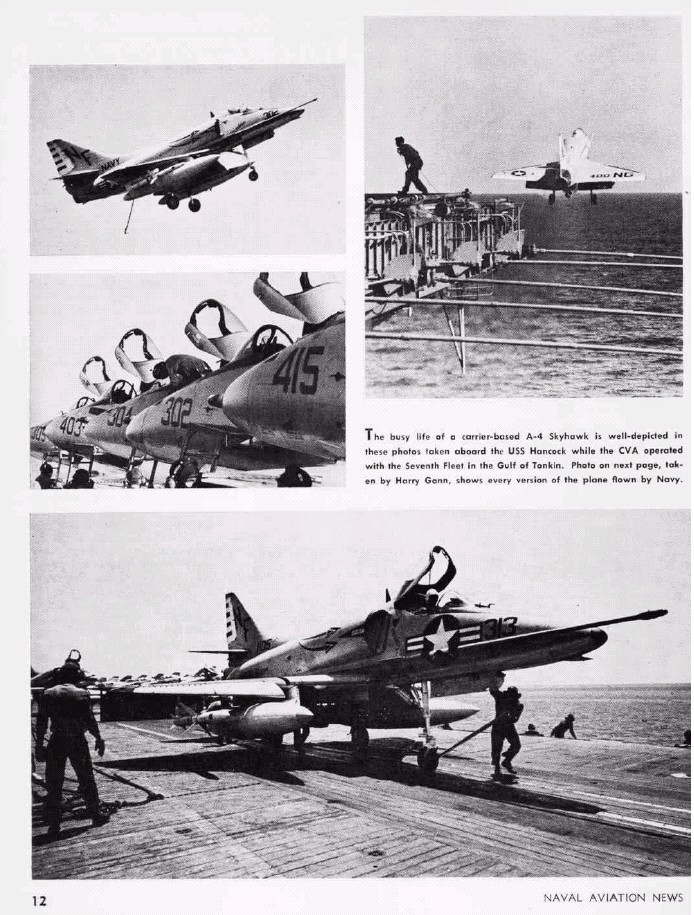
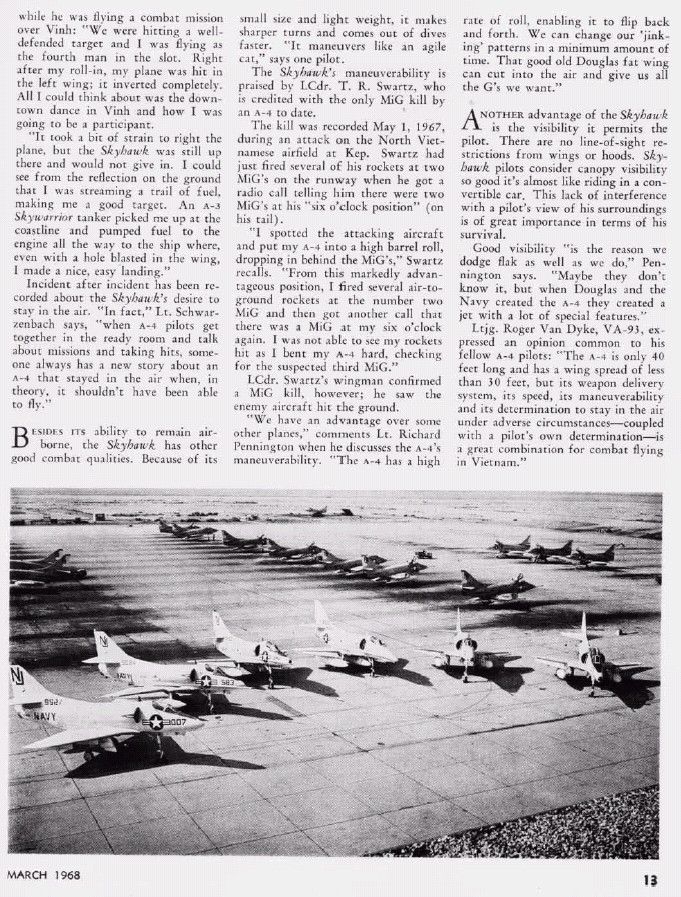
For the most part, single-seat A-4s were used in Southeast Asia, the Middle East and the Falklands to do interdiction and point target bombings. To do CAS after ground troops have located the enemy, A-4s could be directed by radio talk-ons and today lasers and GPS and this would be in actuality DAS/SAD. The question is could a TWO-SEAT A-4 be flown 24/7/365 from small, impromptu air bases or even strips of road after being unlimbered from a trailer or from inside an ISO container "BATTLEBOX" to be our o/a grasshoper today? First, we have to have the A-4s, where did they all go? We built 3, 000 of them!
The Texas Connection: Who Killed the A-4 SkyHawk? Why isn't it in U.S. Service Today?
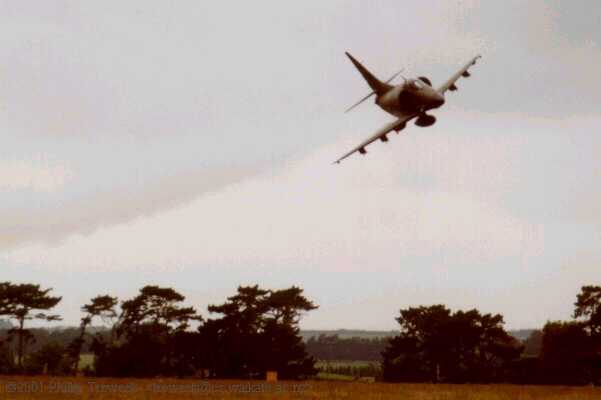
What killed the California-made Douglas A-4 was the very same thing that killed the California-made Douglas A-1 SkyRaider; rivals in the Military Industrial Congressional Think Tank (MICC-TT) Complex.
The Navy and marines were rightfully very happy with the A-4 (and it should be their opinions that should count most when they are well-founded) and had every intention to keep production lines going with the A-4D-6 model which would have had a TF30 turbofan engine used in the made-in-Texas F-111 TFX replacing the J52 turbojet to improve RANGE, BOMBLOAD and SPEED.
However, Texas corporation, Vought whined that it was not making any aircraft and cried "foul!" to DoD (or someone else they had political connections with, now who could that have been? Got any ideas?) and demanded a "competition" be opened for a new light attack plane. The VA (L) competition ended up in Vought "winning" under the corrupt Texan Lyndon B. Johnson's administration that entered office under the cloud of actual WW2 Navy hero, John F. Kennedy's assassination in Dallas, Texas. In 1960 the Democratic Party selected John F. Kennedy as its presidential candidate. Aged only 43, Kennedy was politically inexperienced and very unpopular with certain sections of the party. Kennedy's Republican Party opponent was Richard Nixon, had a long-career in politics and had served for eight years as vice president under Dwight Eisenhower. Party managers believed that Johnson would make an ideal running-mate for Kennedy. Although reluctant, Kennedy eventually agreed, telling his aide Kenneth O'Donnell: "I'm forty-three years old, I'm not going to die in office. So the vice presidency doesn't mean anything." Texas back-room deal politician Johnson in WW2 had re-made himself into a Navy "hero" by flying in a plane over a Jap-held island for later political capital gains. To make matters worse, the Texas "mafia" had earlier damned the U.S. Army to repeated helicopter shoot-downs by Bell Helicopter in Texas mass-producing slow, loud, noisy helicopters instead of the much faster McDonnell helicopters and converti-planes. Bell was still not contented and whined when it didn't "win" the Light Observation Helicopter (LOH) competition against the superior Hughes Model 500 Little Bird and got itself a contract to build Bell Jet Rangers against the Army's wishes to fly the better helicopter which perpetuates to the present with the absurd, loud, slow Model 407 "replacing" the previous OH-58D Kiowa Warrior porkster that at least had some Army tactical capabilities embedded into it instead of just being a cheapo civilian helicopter in dark Army green so it can be easily shot down while keeping Bell's share holders rich as the working class sends its sons and now feminist daughters to self-validate themselves as "warriors" and die in these flying deathtraps. This time the Army likely bought off by promises of post-retirement employment chose the inferior Bell helicopter over the superior MD500 Little Birds which if the ARH requirement had stated needed to be STEALTHY could have been the superior NOTAR model. See the pattern here? We'll give you a hint. TEXAS, TEXAS, TEXAS, TEXAS. Did we say Texas? If you think this is just a "coincidence", the Texas native Secretary of the Navy who instigated these aircraft shennanigans, John B. Connally had to resign under ethics violations towards the middle of the JFK administration. Replacing him was someone just as corrupt as he was! And guess where he lived? TEXAS.
www.spartacus.schoolnet.co.uk/JFKkorth.htm
Fred Korth was born in Yorketown, Texas, in 1909. His older brother, Romeo Korth was instrumental in implementing rural electrification for South and Central Texas.During the Second World War he served in the Air Transport Command. By 1945 he had reached the rank of lieutenant-colonel. After the war he worked as a lawyer in Forth Worth, Texas. He joined the Democratic Party and worked with John Connally in helping Lyndon B. Johnson in his 1948 election campaign.
In 1952 Harry S. Truman appointed Korth as Assistant Secretary of the Army. He worked under Frank Pace. Both men left office in 1953. Pace became chief executive of the General Dynamics Corporation in Texas. Korth returned to his law practice. He also became director of the Bell Aerospace Corporation. The chairman of the company, Lawrence Bell, was a fellow member of the Suite 8F Group. Korth also became president of the Continental National Bank of Fort Worth. This was one of General Dynamics bankers.
In the last few months of the administration of Dwight Eisenhower, the Air Force began to argue that it needed a successor to its F-105 tactical fighter. This became known as the TFX/F-111 project. In January, 1961, McNamara, changed the TFX from an Air Force program to a joint Air Force-Navy under-taking. On 1st October, the two services sent the aircraft industry the request for proposals on the TFX and the accompanying work statement, with instructions to submit the bids by 1st December, 1961. Three of the bids were submitted by individual companies: the Lockheed Aircraft Corporation, the North American Aviation Corporation and the Boeing Company. The other three bids represented team efforts: Republic Aviation & Chance Vought; General Dynamics Corporation & Grumman Aircraft; and McDonnell Aircraft & Douglas Aircraft.
It soon became clear that Boeing was expected to get the contract. Its main competitor was the General Dynamics/Grumman bid. General Dynamics had been America's leading military contractors during the early stages of the Cold War. For example, in 1958 it obtained $2,239,000,000 worth of government business. This was a higher figure than those obtained by its competitors, such as Lockheed, Boeing, McDonnell and North American. More than 80 percent of the firm's business came from the government. However, the company lost $27 million in 1960 and $143 million in 1961. According to an article by Richard Austin Smith in Fortune magazine, General Dynamics was close to bankruptcy. Smith claimed that "unless it gets the contract for the joint Navy-Air Force fighter (TFX)... the company was down the road to receivership".
General Dynamics had several factors in its favour. The president of the company was Frank Pace, the Secretary of the Army (April, 1950-January, 1953). The Deputy Secretary of Defense in 1962 was Roswell Gilpatric, who before he took up the post, was chief counsel for General Dynamics. The Secretary of the Navy was John Connally, a politician from Texas, the state where General Dynamics had its main plant.
Connally left the job in January 1962 and John F. Kennedy now appointed Korth as Secretary of the Navy. According to author Seth Kantor, Korth only got the job after strong lobbying from Lyndon B. Johnson. A few weeks after taking the post, Korth overruled top Navy officers who had proposed that the X-22 contract be given to Douglas Aircraft Corporation. Instead he insisted the contract be granted to the more expensive bid of the Bell Corporation. This was a subsidiary of Bell Aerospace Corporation of Forth Worth, Texas. This created some controversy as Korth was a former director of the company.
Korth also became very involved in discussions about the TFX contract. Korth, was the former president of the Continental Bank, which had loaned General Dynamics considerable sums of money during the late 1950s and early 1960s. Korth later told the John McClellan committee that investigated the granting of the TFX contract to General Dynamics "that because of his peculiar position he had deliberately refrained from taking a directing hand in this decision (within the Navy) until the last possible moment."
As I. F. Stone pointed out, it was "the last possible moment" which counted. "Three times the Pentagon's Source Selection Board found that Boeing's bid was better and cheaper than that of General Dynamics and three times the bids were sent back for fresh submissions by the two bidders and fresh reviews. On the fourth round, the military still held that Boeing was better but found at last that the General Dynamics bid was also acceptable." Stone goes on to argue: "The only document the McClellan committee investigators were able to find in the Pentagon in favour of that award, according to their testimony, was a five-page memorandum signed by McNamara, Korth, and Eugene Zuckert, then Secretary of the Air Force."
McNamara justified his support for General Dynamics because "Boeing had from the very beginning consistently chosen more technically risky tradeoffs in an effort to achieve operational features which exceeded the required performance characteristics."
The TFX program involved the building of 1,700 planes for the Navy and the Air Force. The contract was estimated to be worth over $6.5 billion, making it the largest contract for military planes in the nation's history.
On 24th October, 1962, Seth Kantor reported in the Fort Worth Press that: "General Dynamics of Fort Worth will get the multibillion-dollar defence contract to build the supersonic TFX Air Force and Navy fighter plane, the Fort Worth Press learned today from top Government sources."
This was confirmed the following month when the Pentagon announced that the TFX contract would be awarded to General Dynamics. Henry M. Jackson was a member of the Senate Armed Services Committee, the Senate Government Operations Committee and the Permanent Subcommittee on Investigations. He learned that: "Boeing's bid was substantially lower than its competitor's. Reports indicated Boeing's bid was $100 million lower on an initial development contract and that the cost difference might run as high as $400 million on the total $6.5 billion procurement."
On 12th December, Lyndon B. Johnson visited Forth Worth to join in the festivities at the General Dynamics plant. Congressman James Wright, the Texas Democrat representing the Fort Worth district introduced Johnson as the "greatest Texan of them all". He pointed out that Johnson had played an important role in obtaining the TFX contract. Wright added "you have to have friends and they have to stick with you through thick and thin even if you do have merit on your side."
During the McClellan's Permanent Investigations Committee hearings into the contract, Senator Sam Ervin asked Robert McNamara "whether or not there was any connection whatever between your selection of General Dynamics, and the fact that the Vice President of the United States happens to be a resident of the state in which that company has one of its principal, if not its principal office." At this point McNamara was close to tears and commented that: "Last night when I got home at midnight, after preparing for today's hearing, my wife told me that my own 12-year-old son had asked how long it would take for his father to prove his honesty."
McNamara rejected the idea that Lyndon B. Johnson was involved in the decision but evidence was to emerge that he did play an important role in the awarding of the TFX project to General Dynamics. For example, William Proxmire found some interesting information on the TFX project while investigating the role played by Richard Russell in the granting of the C-5A contract to Lockheed. The C-5A was built in Marietta, Georgia, the state that Russell represented. The Air Force Contract Selection Board originally selected Boeing that was located in the states of Washington and Kansas. However, Proxmire claimed that Russell was able to persuade the board to change its mind and give the C-5A contract to Lockhead.
Proxmire quotes Howard Atherton, the mayor of Marietta, as saying that "Russell was key to landing the contract". Atherton added that Russell believed that Robert McNamara was going ahead with the C-5A in order to "give the plane to Boeing because Boeing got left out on the TFX fighter." According to Atherton, Russell got the contract after talking to Lyndon Johnson. Atherton added, "without Russell, we wouldn't have gotten the contract".
On 26th June, 1963, Clark R. Mollenhoff managed to interview Robert McNamara about his role in awarding the TFX contract to General Dynamics. McNamara claimed that Johnson had applied to political pressure on him concerning the contract. He admitted that he knew all about Fred Korth's business relationship with General Dynamics and Bell Aerospace. He also revealed he was aware of Roswell Gilpatric's role "as a lawyer for General Dynamics just prior to coming into government, the role of Gilpatric's law firm in continuing to represent General Dynamics, and the amount of money Gilpatric had received from the law firm since becoming Deputy Defense Secretary". However, he was convinced that this did not influence the decision made by Fred Korth and Roswell Gilpatric.
John McClellan, chairman of the Permanent Investigations Committee, continued looking into the activities of Billie Sol Estes and Bobby Baker. During this investigation evidence emerged that Lyndon B. Johnson was also involved in political corruption. This included the award of a $7 billion contract for a fighter plane, the TFX, to General Dynamics, a company based in Texas. When it was discovered that the Continental National Bank of Fort Worth, was the principal money source for the General Dynamics plant. As a result of this revelation Korth resigned from office in October, 1963.
On 22nd November, 1963, a friend of Baker's, Don B. Reynolds told B. Everett Jordan and his Senate Rules Committee that he saw a suitcase full of money which Baker described as a "$100,000 payoff to Johnson for his role in securing the Fort Worth TFX contract".
John McClellan, the chairman of the Senate subcommittee investigating the TFX contract said that he wanted to interview Don Reynolds. However, for some reason the subcommittee did not resume its investigation until 1969, after Johnson had left office.
After resigning as Secretary of the Navy, Korth worked as a lawyer in Washington. In 1969 he was elected to the board of OKC Corporation in Dallas. Later that year Fred Korth's daughter Verita, supposedly killed herself with a 20 gauge shotgun.
Fred Korth died in El Paso, Texas in September 1998. He is buried under a three century old Texas Live Oak tree on his ranch in Karnes County, Texas.
"Governor" Connally would be later riding in the limo with JFK on November 22, 1963 in Delaye Plaza in Dallas, Texas to give himself the perfect alibi, but the shooters were not as good as promised and he screamed as he himself was hit; "My God, they are going to kill us all!", a revealing remark he recanted later to prevent a second application of gunfire, this time more intentional and more personal.
If an aircraft doesn't have a "future" in the form of an improved letter "B", "C", "D" model variant, its living on borrowed time. Most aircraft are fragile and must be pampered to be safe to fly, and military high-performance aircraft are so crash-prone they have their pilots on a rocket seat ready to blast out the second it begins to falter. When the SkyRaider improvement stopped when the needed contraprop Sky Shark's XT40 turbine engines failed, it no longer had a "future" in the eyes of the easily-defeated-in-the-face-of-internal-adversity and jet jock-dominated Navy airdale community. When the A-7 Corsair II got built instead of a turbofan equipped SkyHawk, in the minds of the Navy bureaucracy they somehow could never from then on even consider turbofan engining the A-4. This absurd, lemming lockstep, damned us into a situation military reformer iconoclast Chuck Spinney calls the "death spiral". Its a situation akin to Rod Serling's "Twilight Zone" but without the Aesop warning to prevent the catastrophe. As good as the A-7 was/is, it only provided a marginal improvement in bomb and range performance over the A-4 at much greater costs such that only small numbers could be bought. At no time could the A-7s be bought as a 1-for-1 replacement for the 3, 000 total production A-4s; resulting in more and more money being spent on less and less aircraft until such time that complexity would result in impotence as A-4 creator Heinemann warned us would happen. To the peaceniks, at some point the super-uber plane would cost so much we could only afford ONE, and on the day of the war, its tires would be flat and we couldn't fight. We'd all have to "call it a day" and head to the officer's club...not so fast, sherlock....
The problem is that the "death spiral" isn't happening to the ENEMY and he seems always able to ratchet down his technoBS to put into his hands real weapons that kill and maim REAL PEOPLE, so WE THE PEOPLE had damn well better be able to defend ourselves and get control over our out-of-control, run-by-madmen defense establishment. However, right now the U.S. Navy's aviation is so bankrupt its only one aircraft away from the Spinney fighter-with-a-flat-tire outcome. Never able to economize or focus on the enduring aspects of military force applied over the earth, the Navy and later the marines have been on a spending binge ever since WW2 began fueled by the public adulation their PR machines have created for themselves exploiting the American knee-jerk blood lust for Pearl Harbor revenge against the "Japs" (who were just taking our strategic ambush bait to doom the Axis) when the real threat and victory in WW2 was defeating the GERMANS who could have actually annihilated America with nuclear weapons had we delayed over-running them by just a few more weeks. Rather than find durable platforms that could remain in production and service for years-at-a-time, the Navy wants to exploit its self-created "smallness" of only having a dozen "supercarriers" henceforth known as "stuporcarriers" to only need to build small batches in a few years of several hundred planes so every few years it could switch out model types to compensate for their inferiority complex vis-a-vis landplanes that are not weighted down with carrier landing gear. Every time the Navy switched out to a "new" type of plane it generated (there is a reason why we are saying this in past tense) a huge amount of turmoil and logistical costs to a plane already burdened with being in a salt water and accident-prone environment of the pitching flight deck at sea several stories high above the turbulent water. We are now at the point where there is only 1, that's right, 1, O-N-E, only one naval aircraft being developed and its not even being funded by them, its a "joint" program held together by the USAF and marines leverage with Congress to provide funds; the F-35 Lightning II Joint Strike Fighter (JSF). If the F-35 falters in any way, U.S. Naval aviation is finished with no future whatsoever with a service so corrupted and broke it cannot bring itself to cutting back on its capital ship stuporcarrier addiction even to stop the cancer before it kills them. To try to get the Navy blue Humpty-Dumpty back together, technopundits pontificate about "UAVs" being cheap and affordable and available to fill flight decks; the realist will see this as self-created kamikazes destroying everything in sight and setting off horrific fires and explosions with the known 50% UAV crash rate.
Corporate greed and military bureau-egos eventually killed the A-4 with the start of the terminal phase of the death spiral cancer. By 1960, the Navy should have realized the WW2 total war mobilization days were over and they needed to stop their small batch keep-up-with-the-joneses technoinferiority complex mentality. They couldn't and shouldn't keep getting a brand new airplane type every 5 years; the CAS mission defined by the need of the aircraft to fly low and slow enough to see the enemy and precision deliver affordable, unguided ordnance requires a durable platform made in high quantities which should have been successive versions of the A-1 SkyRaider prop plane. For interdiction and perhaps supplemental CAS with a second back-seat observer/AFAC, the A-4 SkyHawk should have been improved with at first a single turbofan engine and when possible a twin turbofan combination to reduce aircraft losses further. The A-6 Intruder "all-weather" bomber was a lie from the get-go and should never have been built. NO PLANE FLIES IN ALL WEATHER ON PLANET EARTH AND ITS DAMN TIME THE AVIATORS STOP SAYING SUCH A THING EXISTS.
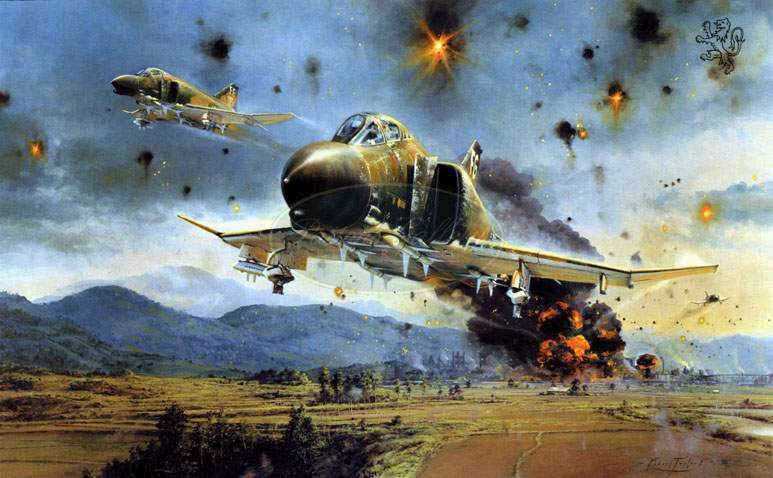
If you interdiction bomb, you use A-4s and F-4s not doing anti-air warfare MIG CAP.
The Navy should have realized it needs 100 small aircraft carriers to control the seas made from civilian cargo container ships and by the previously mentioned tactically sound frugality measures, would have had the monies to develop an attack seaplane that would be operable by ALL of its surface ships as well as from civilian cargo ships to defend themselves from air and sea attacks---the A-4 Model 640 seaplane would have been ideal. Size and numbers still matter on our very large planet earth. If for whatever the reason, the "SeaSkyHawk" could not land on the dry deck carrier---no problem; it lands on the water and is recovered for re-use. It could even be made of composites to be radar stealthy as well as not be subject to salt water corrosion paranoia. The point here is to have some FRUGALITY and not eat aircraft as the MICC-TT wants to do so we can stay in operation and have the money to MAKE THE REALLY BIG QUANTUM LEAP IMPROVEMENTS WHEN REQUIRED.
By the time the 1980s arrived, the Navy was so broke operating its stuporcarriers and mis-mash of too-many complex aircraft in small batches, it could not field the twin-engined A-12 to get a "stealth" replacement for the A-6. Don't cry for the Navy, Lockheed offered a navalized F-117 Nighthawk---a single engined attack plane ie; equivalent to an A-4 in bombload and the snobby Navy turned them down and now has no precursor aircraft to at least bust enemy integrated air defenses for the rest of its non-stealthy F-18 clusterfucks to penetrate. After the A-4 was unwisely dropped by the CAS hypocritical marines for the crash-prone Harrier (it could be pointed out that the Brits can fly them safely and the problem is the USMC filled with narcissist-morons is not up to the job, if that's the case then keep the affordable A-4s you can fly safely and not go broke) the A-7 in small numbers in the Navy was gone by the end of Desert Storm in 1991, followed by the A-6s after their dismal showing there. Still financially bleeding from its arteries, the Navy retired all its fixed-wing ASW S-3 Viking aircraft and just last year, its AAW F-14 Tomcats in an act of institutional lifeboat but future tactical, operational and strategic suicide. All now rests on overweight, under-powered F-18 Stupor Hornets made in life-support $56M each handfuls at the former McDonnell-Douglas plant bought out by the evil Boeing corporate empire. The USAF has the Navy/Mc where it wants them. The Enemies of America have the Navy/Mc where it wants them. All the former has to do is pull out of the JSF program and it collapses and with it goes naval aviation. All the latter has to do is sink one of the ASW and AAW defenseless stuporcarriers and put 5, 000 men into the water where the live-in-denial, only-wwants-to-do-the-sexy-things-it-wants-to-do Navy has no seaplanes or LTA blimps to rescue them and the American public will pull-the-plug on the stuporcarrier racket as the world pulls-the-plug on considering us a "stupor power" anymore. Maybe a STUPID power, yes, but someone to fear and respect, forget it. We don't deserve it.
Can the A-4 SkyHawk do MAS today?
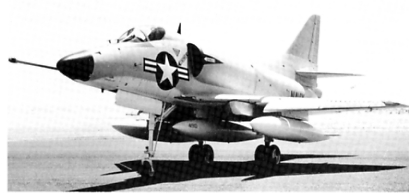
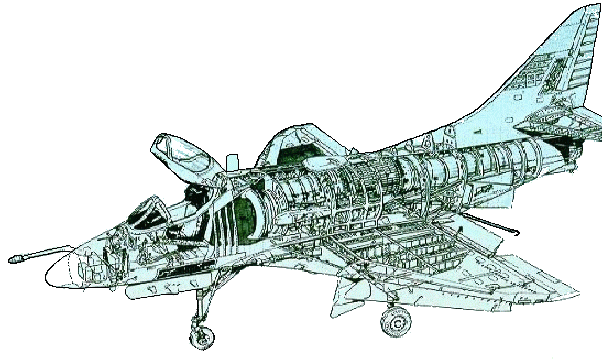
In the 1950s even the U.S. Army considered a double-wheeled A-4 for STOL CAS capabilities...as the rare photo above shows...
According to the SkyHawk organization web page: www.skyhawk.org/2C/productionhistory.htm, in 1961, two A4D-2 SkyHawks (BuNos 148490 and 148483) were borrowed by the U.S. Army and modified by Douglas for evaluation in competition with the Northrop N-156 (predecessor of the F-5) and an Italian Fiat G-91, for operations from unimproved airfields near front lines. Modificatons of the Army SkyHawk included large dual wheels on beefed-up main landing gear mounts; a heavier wing to house the larger landing gear; and installation of an A-3 Skywarrior drag chute. Flown by Douglas test pilot Dru Wood, the modified "Army" SkyHawk won the competition, but the project was cancelled when Army funds were diverted to helicopter procurement.
The Army could have selected a two-seat A-4 and used the SATS system of tailhook snagging arrestor wires to land and jet engine catapults or JATO to launch from a small 2, 000 foot runway made of AM-2 aluminum matting the marines used to get a CAS capability at a forward operating base very close to the places where their ground maneuver troops were fighting so if on strip alert the response times would be quick, using its 650 mph dash speed to get there in a hurry. Had both Army and marines continued with SATS and SkyHawks, perhaps successive models would have had a vectored thrust tail pipe to improve STOL capabilities for shorter and shorter runways.
Since USAF so far refuses to upgrade its A-10s into two-seat OA-10Bs as we propose, the U.S. Army should get its own two-seat MAS aircraft, using the 86 x A-4 Skyhawks in storage at Davis-Monthan AFB AMARC or simply putting A-4s back into production. A man recently made a P-51 Mustang from scratch, brand-new using the power of today's personal computer, so why do we need large MICC-TT corporations to build military aircraft?
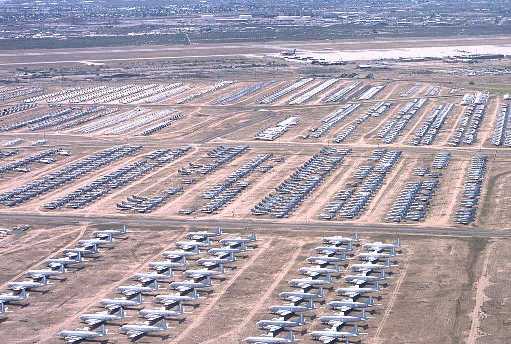
This pic from Davis-Monthan AFB from an aircraft at a slant angle shows P-3 Orion ASW aircraft and lots of A-4 Skyhawks. These Skyhawks could be made into trailer-mobile attack aircraft for MAS and avoid enemy fixed airbase targeting.
The A-4 is a VERY tolerant airplane re AAA/small arms, etc. due to designer Ed Heinemann's design excellence not necessarily by deliberate design requirements.
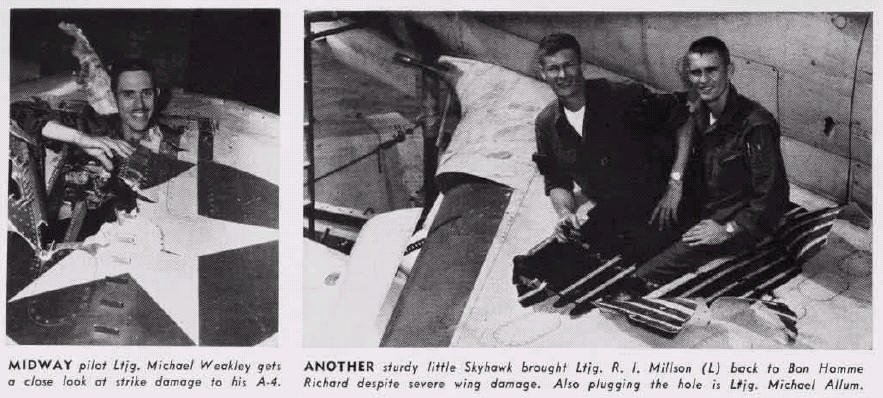
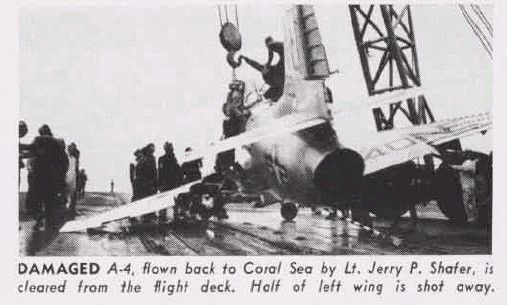
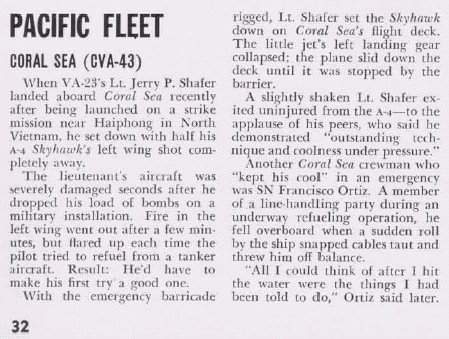
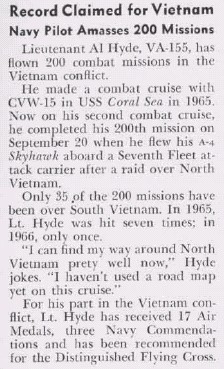
Chuck Myers, the creator of the Maneuver Air Support (MAS) Concept writes:
"I did the aircraft loss/damage analyses for SEA while working at WSEG. The A-4 had the best survivability rate for aircraft damaged from air defenses on missions into N. Vietnam. It came home to carriers on its damaged single J-52 when F-4s couldn't make it with damage to one of its J-79s. The P&W J-52 was tough. Israeli A-4s flew with tailpipe extensions; the secret to taking damage from IR SAMs.
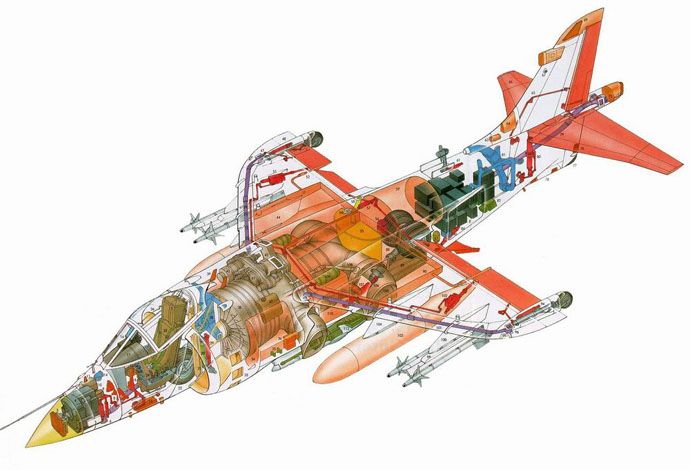
IR SAMs are limited in warhead size. They love the AV-8 because: guess where the hot spot is?
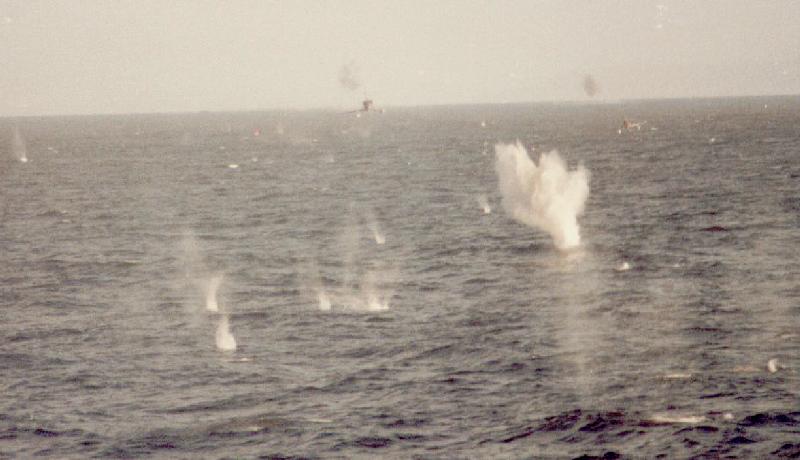
Harriers had some success against Mirage because of advanced AIM-9L and the fact that they were there because they were STOVL and could fly from UK miniature carriers, not because of any other attribute. Harrier is a poor maneuvering aircraft. Very high wing loading!! Poor cockpit visibility. A-4 and Mirages attacking UK fleet were operating at the end of their tether. If they had prepared base in Falklands, the fleet would never have gotten close enough.
Half the A-4s hit by the SAM-7 in the Arab/Israeli conflicts got home-but that was also due to the little warhead of Grail but protection is more a function of what type countermeasures you apply; the basic aircraft is very robust. The A-4 is the antithesis of the AV-8. AND, it is VERY agile and small and hard to see (used in the film, "Top Gun"). Illustrates the stupidity of MC giving up the A-4 to go to AV-8 at about triple the life cycle cost."
Want to see how sturdy the SkyHawk is?
A military that needs CAS attack aircraft like the U.S. Army that is on a tight budget is the Philipine Air Force. Opus224 writes about the SkyHawk as an option:
www.geocities.com/opus224/modernization-paf.htm
A-4 SKYHAWK as Interim Fighter and Strike AircraftRegarded as a "classic" by any measure and was (and still is) a superb close-air-support and interdiction platform. It first entered service in October, 1956 and had the longest production run of any tactical aircraft at about 25 years. Total production of all variants reached 2,960 aircraft. Its original mission was the delivery of tactical nuclear weapons and it was the U.S. Navy and marine corps principal ground attack aircraft, seeing extensive use in the Vietnam War.
Israel was the largest export customer for Skyhawks, with some 350 newly manufactured A-4Hs (modified A-4Fs), A-4Ns (modified A-4Ms), and TA-4 trainers, and refurbished A-4Es delivered between 1967 and 1973. The Skyhawks, called "Ahit" or "Vulture" in IAF service, saw extensive combat use. Israeli modifications included the replacement of the U.S. Mk. 12 20mm guns with French DEFA 553 30 mm. cannons and the extension of the tailpipe to better handle damage from tail-chasing shoulder-launched SA-7 missiles.
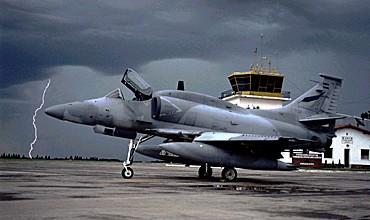
Argentina is another old Skyhawk user, having first ordered refurbished U.S. examples in 1966. The Fuerza Aera (FAA) and Comando Aviacion Naval Argentina (CANA) used their A-4s against the British during the Falklands War, where their pilots performed gallantly and sank or contributed to the sinking or scuttling of a destroyer, two frigates and a Royal Fleet Auxiliary ship. Losses were heavy, 22 out of 35 A-4s on strength were lost, as the Skyhawks were at the outer edge of their range and did not have enough fuel to perform evasive maneuvers. It is said that if the Argentinians had adequate aerial tanker support the British would have had a much harder time dealing with them. The FAA had 2 KC-130s tankers but even with these the A-4s were at their range limit. Recently, the FAA took delivery of 36 upgraded and refurbished ex-U.S. marine corps A-4M, redesignated A-4AR Fightinghawks. These were upgraded with AN/APG-66 multimode radars, HOTAS controls and advanced avionics, and had their J-52 engines zero-timed.
Another user, Singapore, currently operates about 60 Skyhawks. Upgrades included replacement of the 8,400-lb-thrust J65 engines with 11,000-lb-thrust F404 GE100D turbofans, essentially non-afterburning versions of the engines of the F/A-18 Hornet, and advanced avionics and improved air-to-air and air-to-ground ordnance carrying and control capability.
New Zealand was another export customer, having received 24 A-4s from U.S. and Australian stocks. In 1986 New Zealand initiated Project Kahu - a major upgrade for its Skyhawks which included the installation of a Westinghouse AN/APG-66 radar optimized for maritime tracking, HOTAS controls, MIL-STD 1553B databus; Litton LN-93 inertial navigation system, Ferranti wide-angle HUD, chaff and flare dispensers and various structural modifications. The aircraft also received armament upgrades including the capability to fire AIM-9L Sidewinders, AGM-65 Mavericks and GBU-16 laser guided bombs. Though the project was deemed highly successful, New Zealand sought to modernize its air force with the lease (with option to purchase) of the previously embargoed Pakistani F-16s for a bargain price from the United States. To make the deal more attractive, the U.S. had offered to finance the sale of the RNZAF A-4s to the cash-strapped Philippines, and, according to a Brazilian newspaper article, had actually blocked the Philippines' attempts to purchase F-5Es from Switzerland (According to the article, the U.S. invoked the F-5 licensing agreement with Switzerland prohibiting the resale of the fighters to a third country, in this case the Philippines, but it raised no objections to Brazil's purchase of the same aircraft). Regardless, the U.S. deal with New Zealand for the F-16s fell through with the assumption of Helen Clark as NZ Prime Minister. Her government cancelled the F-16 agreement and subsequently abolished the armed component of the RNZAF. The Skyhawks and MB-339s trainers were all put in storage as of December, 2001 awaiting buyers. Before that date two of the 19 remaining Kahu Skyhawks crashed. One of the accidents was attributed to pilot "stress" at seeing his career as a fighter pilot coming to an end.
An American company, Advanced Training Systems International based near Phoenix, Arizona, recently purchased 13 ex-Israeli Skyhawks: ten single seat A-4Ns and three two-seat A-4Js. The company had originally provided aviation ground training for pilots and tested aircraft components for industry, and with their aircraft now provides a bigger variety of services for the U.S. military, including anti-air and anti-ship adversary simulation. They also offer the same services, as well as flight training to foreign military pilots.
U.S. Federal law prohibited the sale of tactical jets to civilian operators so ATSI turned to Israel. The aircraft had been stored in the desert for some years and to refurbish them, Israeli Aircraft Industries and SAFE Air of Blenheim, New Zealand both bid for the contract. IAI was prepared to bring the aircraft only up to Israeli Air Force standards, whereas SAFE Air was prepared to bring the A-4s up to U.S. Navy standards. The contract was awarded to SAFE, which has had extensive experience with refurbishing and upgrading the RNZAF's and Indonesian Air Force's Skyhawks.
Both SAFE and ATSI joined forces to bid for the refurbishment and upgrading of the ex-Kuwaiti A-4KUs purchased by the Brazilian Navy. This bid was lost to another company that underbid them by $3 million, and which subsequently failed to do the job properly when it tried to work with the lower sum. At this point ATSI had moved on to more lucrative projects.
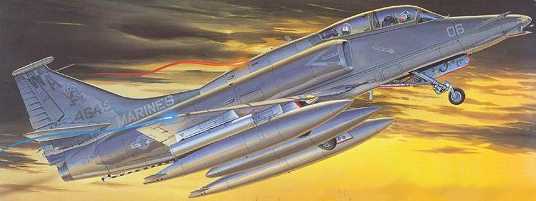
Kuwaiti A-4 SkyHawks in Iraqi Combat during Desert Storm I
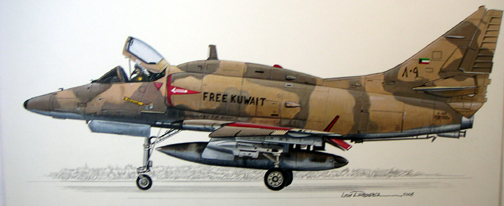
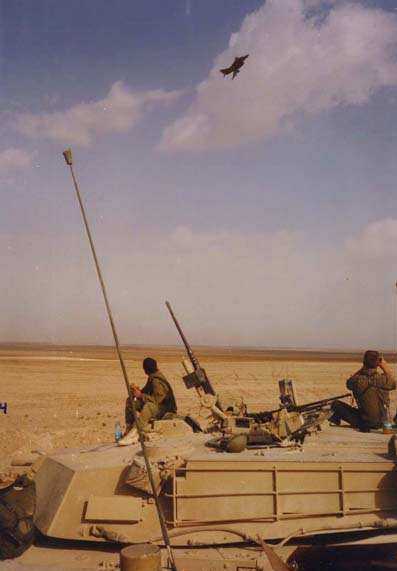
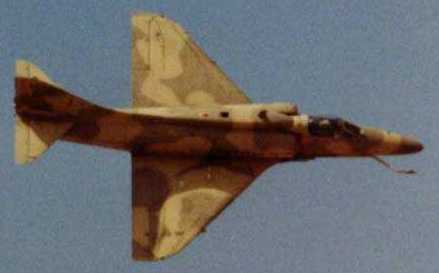
An A-4 program expert writes:
"I've done all this. I was the contract Director for the Phillippine Air Force A-4 fleet from Kuwait. I worked with McD on this a lot. Long Story.
I did several presentations on the F/A-400 Skyhawk replacement, light attack aircraft programme. Forget the F404. You want a dry version of the EJ-200. You only get a range increase and some climb and ceiling performance. Payload and speed are pretty much unaffected, if you stick with the basic A-4 Design.
P&W have a upgrade for the J52-408, that reduces TBO massively. Never should have gone out of production.
My head of Maintenance in for the Ku fleet was a former USMC major who worked on the OA-4M modification programme. It was not a success by all accounts. The OA-4M was very under powered because of all the extra gear shoe horned into it, and not installing the J-52-P408.
You'd also want to put in an Frameless F-16 type canopy, to get better visibility, and install a 1553 or better type databus for the Nav Attack system. You can also fit quite a decent Elbit built radar in a TA-4Ku nose, as well.
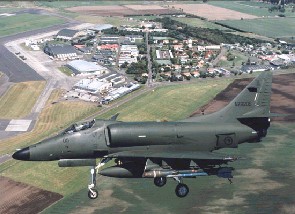
The A-4K flown by the RNZAF was pretty capable but very under powered with only a J-52 P8 (?) IIRC"
Singapore Air Force Success with Super SkyHawks
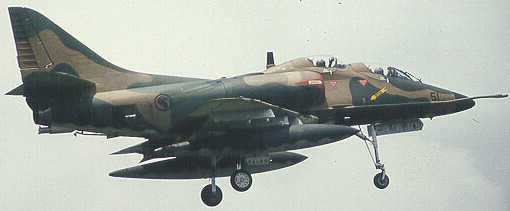
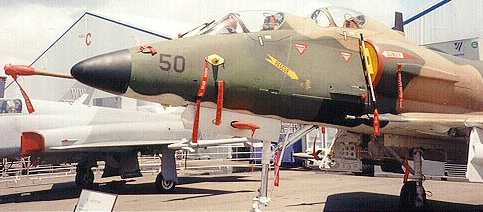
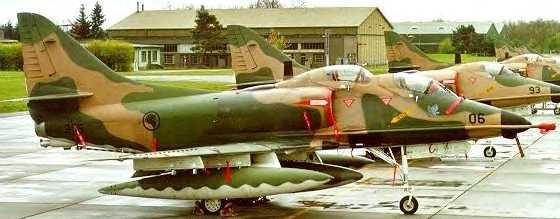
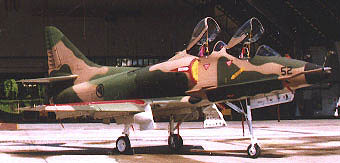
The Singapore Air Force has had great success up-engining their A-4 Skyhawks with powerful non-afterburning F404 turbofan engines creating "Super Skyhawks".
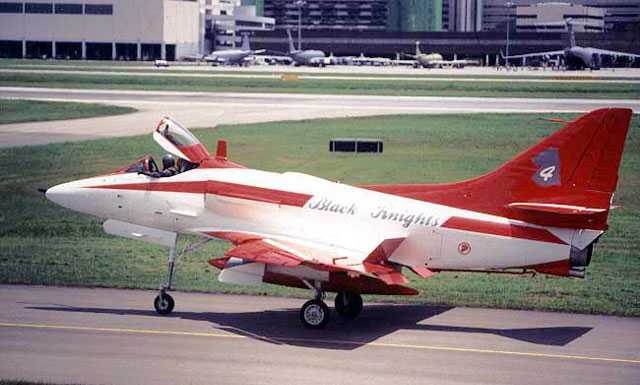
Brazilian Navy SkyHawks
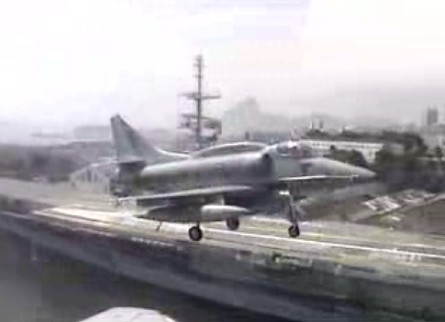
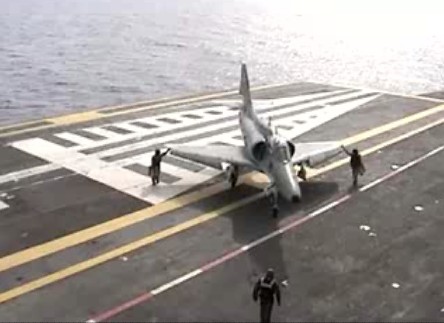
The Argentines have beefed up their SkyHawks: I wouldn't want to send an invading surface fleet against them again!
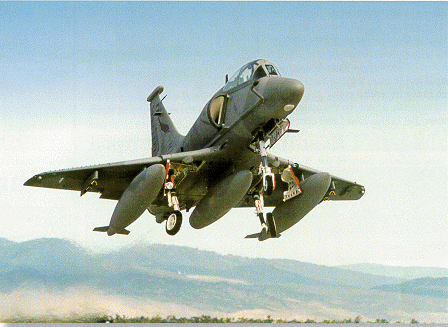
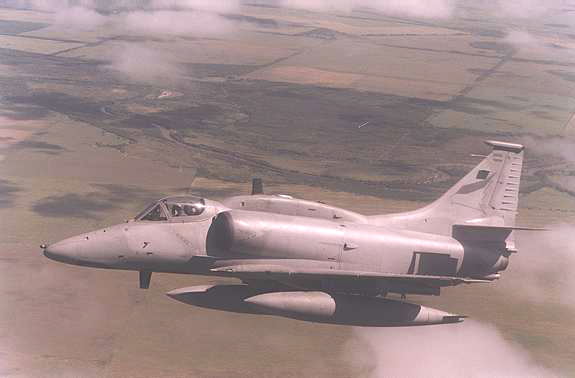
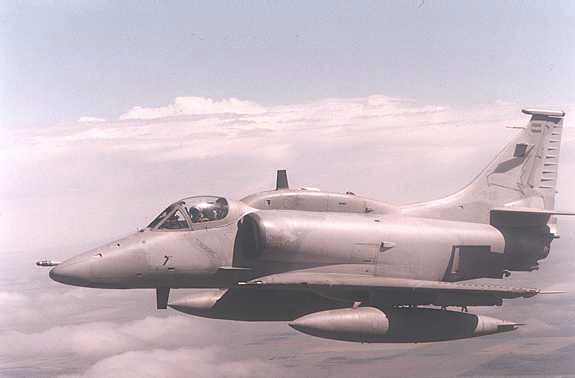
Israeli Skyhawks: still in action; last combat in 1996
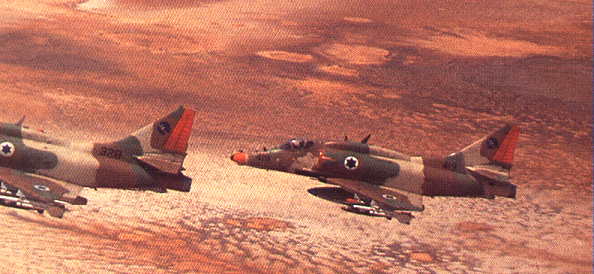
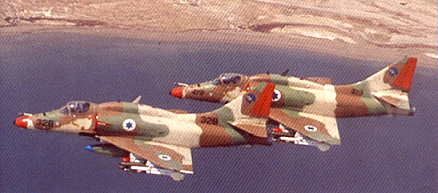
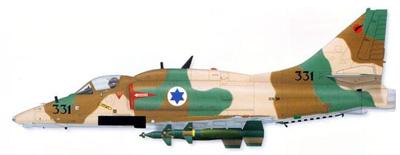
Anti-Air Warfare: is newer better? F-86s shoot down MIG-21s, other aircraft do the same? Why not A-4s?
The IAF has an ace who shot down two MIG-17s in an A-4 Skyhawk!
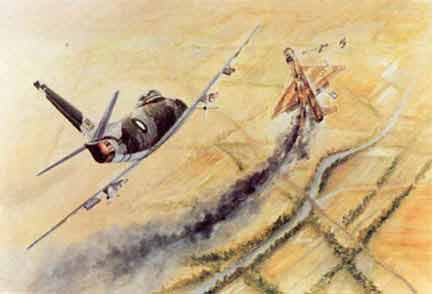
1965 Indo-Paki War
www.pafmuseum.com.pk/contents/m65rafiquiopens.htm
1966: Southeast Asia: ASW carriers had A-4s with AAMs on alert
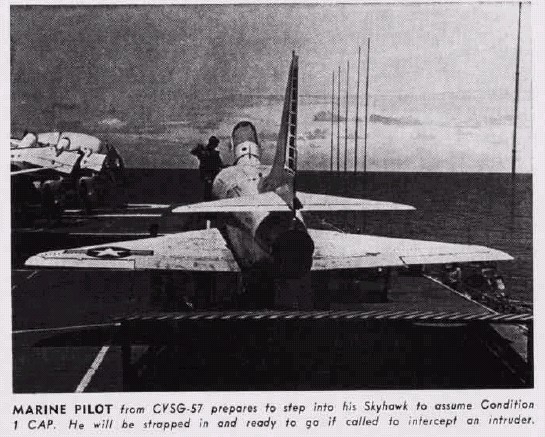
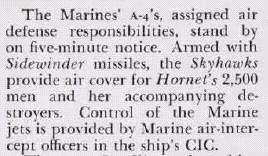
Did we lose some unarmed ASW planes in the Southeast Asia area to MIGs? Since F-4s were too large to operate from Essex class carrier angled decks, we AAM missile armed A-4s! Frankly ALL maritime and transport aircraft should be armed with at the very least rear-ward facing AAMs to self-defend against MIGs since they are not always going to have fighters around them to escort them!
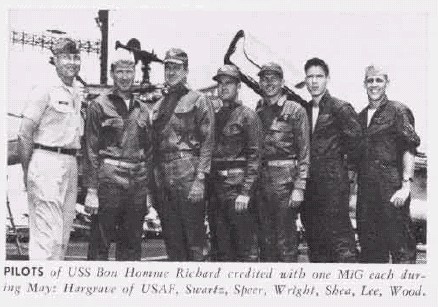
Here is a pic of LCDR Ted Swartz USN who shot down at least 1 if not two, North Vietnames MIG-17s with UNGUIDED rockets!
1971 Indo-Paki War
www.pafmuseum.com.pk/contents/m71f86killsmig21.htm
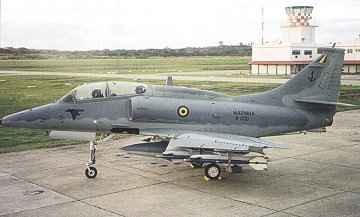
So why couldn't A-4 SkyHawks, A-37 Dragonflies and other aircraft armed with air-to-air missiles like Sidewinders and beyond visual range AMRAAMs not be able to shoot down MiGs, too? Properly armed with AMRAAM missiles why wouldn't SkyHawks be able to shoot down anything in the sky from beyond visual range? These excuses by USAF/Navy narcissists that we cannot use simple aircraft like A-4 Skyhawks as the low end of a high-low mix and we must only have ultra expensive fighters in ever decreasing numbers is dangerous and self-defeating.
VIDEOS
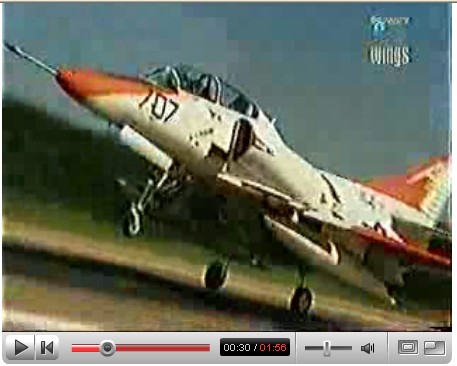
http://www.youtube.com/watch?v=5vdVacZ2llQ
Skyhawk-in-a-Box/Trailer: feasible and desirable
Another benefit of the small, compact Skyhawk is that an ISO container could be developed for it to be carried inside for sea and ground transport. For more details on the benefits of a "Skyhawk-in-a-Box":
Another option would be a simple trailer:
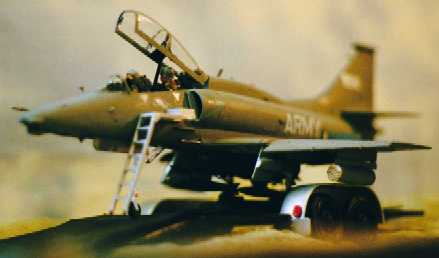
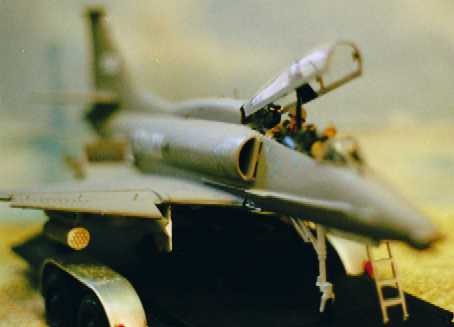
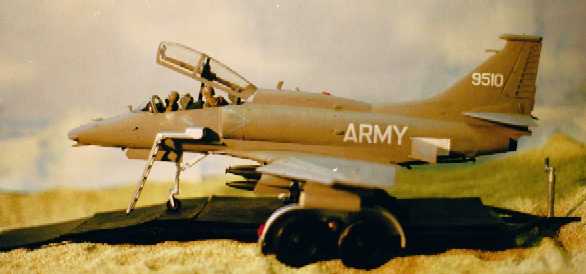
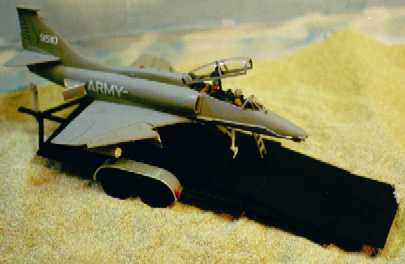
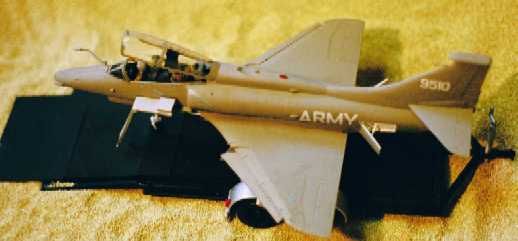
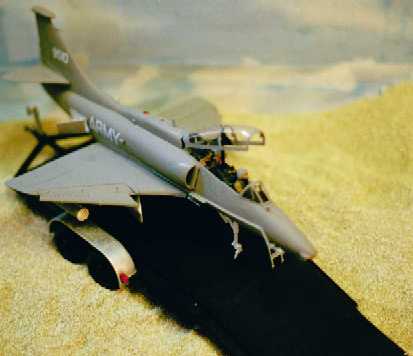
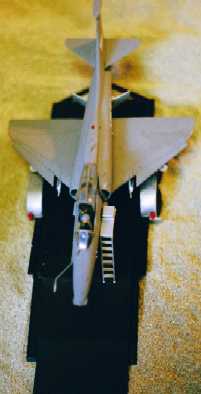
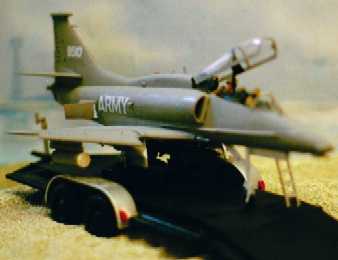
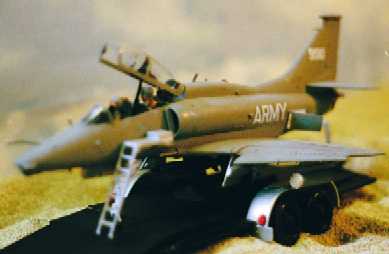
The trailer or BATTLEBOX container could have a rail which is raised with the SkyHawk on it for catapult or ZEL launch!
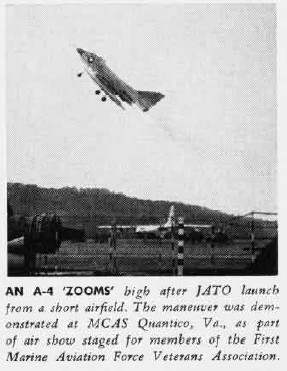
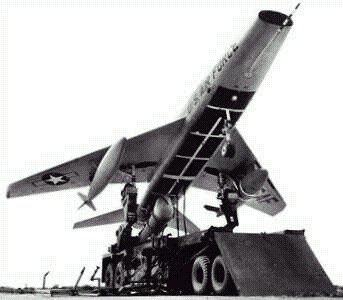
A-4 SkyHawk-in-a-box or on a trailer!

BATTLEBOXaircraft ZEL Transporter-Erector Launchers (TEL) = Aircraft launched instantly like mobile SCUD missiles from constantly position-changing, cross-country mobile, hard-to-detect, camouflaged launchers = Aircraft that don't congregate on obvious open danger area runways/air bases = aircraft that will not get destroyed on the ground
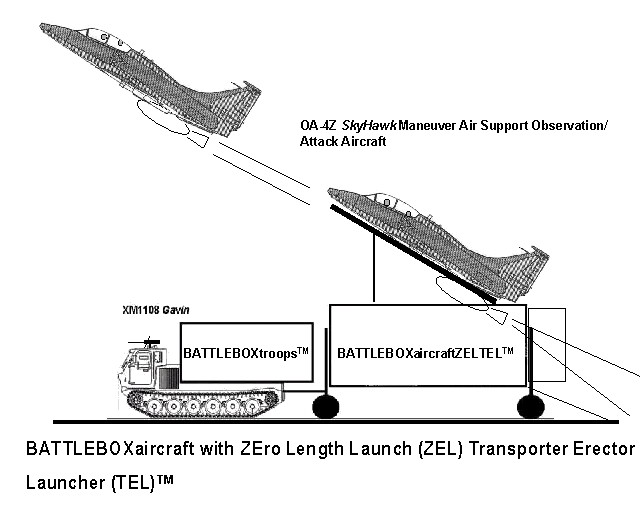
The sad reality is that most aircraft are on the ground at any one time. Today's heavier-than-air jets are too complicated and costly to keep in the air 24/7/365. You can have a few on "scramble" alert status at the end of the runway to take-off and TRY to defend your air base, but the facts are that Welsh & Taylor in today's P-40s are not going to be any more successful at stopping a "Pearl Harbor" counter-air strike than they were on 1941. If you don't have EARLY WARNING and have plenty of time to get your planes loaded with pilots and warmed up, your aircraft are going to get caught on the ground and destroyed IDF 6-day war style. Having LTA blimps and Aerostats that can stay aloft 24/7/365 via air buoyancy can achieve this, but it must not be just radar based defense since radar can be evaded by low-level flights and stealthy constructed aircraft. The video below details how painfully long it takes to check a HTA plane, warm it up, taxi down to the runway which is nothing more than a huge bottleneck denying your aircraft to take off.
Here you see the OV-10 take forever to get airborne like most aircraft. One option air forces do is to place their aircraft in hardened shelters or even in the sides of mountains like the Swiss, Swedes and Red Chinese do. The problem with hardened shelters is their runways give their presence away and eventually enough high explosives directed accurately should blast at least their doors enough to jam the aircraft behind them inside.
What we gather from this video is we need to DISPERSE AND CAMOUFLAGE aircraft so they are not even detected at all and to be able to launch them without runways using vertical launchers in BATTLEBOXes which open up and the MAS plane inside's wings unfold, crew chief does his checks, engines revved up to max thrust and ZIPPP! it takes off right on the spot. This is essentially a "Sink-the-Air Force" concept not unlike what we need to do with the Navy's aircraft via submarine aircraft carriers.
BATTLEBOXaircraftZELTELs would enable tactical-sized FIGHTER-IN-a-BOX aircraft to be always on the go, so even if they were to be spotted by enemy surveillance means they would be long gone by the time attack means were brought to bear. Furthermore, the FIBs could be dug into the ground itself and camouflaged yet the pilots/observers would be nearby in an adjacent BATTLEBOXtroops ready to enter the aircraft, do flight checks, open the top, erect the launcher rail and launch instantly, then lower back down, close the box top and restore camouflage.
Recovering FIB aircraft would be a challenge but if they are LARA 2 seaplane types that can land on water if a lake or river were nearby leaving no tracks or trace and then be picked-up by a prime mover to be taken back to their BATTLEBOXaircraftZELTEL. If the FIB were a LARA 2 type landplane with skis/low ground pressure wheels or event tracks, they could recover on an open grassy field and be picked up and brought back to their BATTLEBOXaircraftZELTELs by a prime mover whose own tracks should be covered by a special track covering vehicle. Air Forces are going to have to start thinking like artillerymen who today go to great lengths to avoid counter-battery fire. And in essence, tactical aircraft except when observing or transporting are nothing more than either air defense or ground bombardment artillery, anyway. Strike aircraft are indeed artillery that flies by aerodynamic lift instead of ballistic projection.
The A-4 is also light enough to be carried underslung a heavy lift helicopter which is handy for recovering crashed planes! This offers another option of recovering them after landing and heli-lifting them back to their BATTLEBOXaircraftZELTEL without leaving any ground vehicle traces.
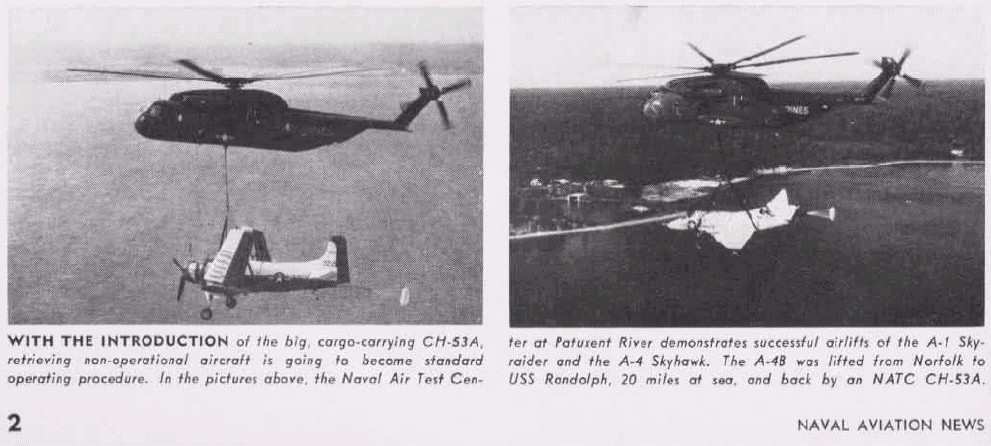
During the Vietnam war, the North Vietnamese would use Mi-6 hook heavy lift helicopters to lift their MIG-17s and MIG-21s from jungle refuel/arming points to runways for take-offs and vice-a-versa to evade American counter-air strikes against their air bases and runways.
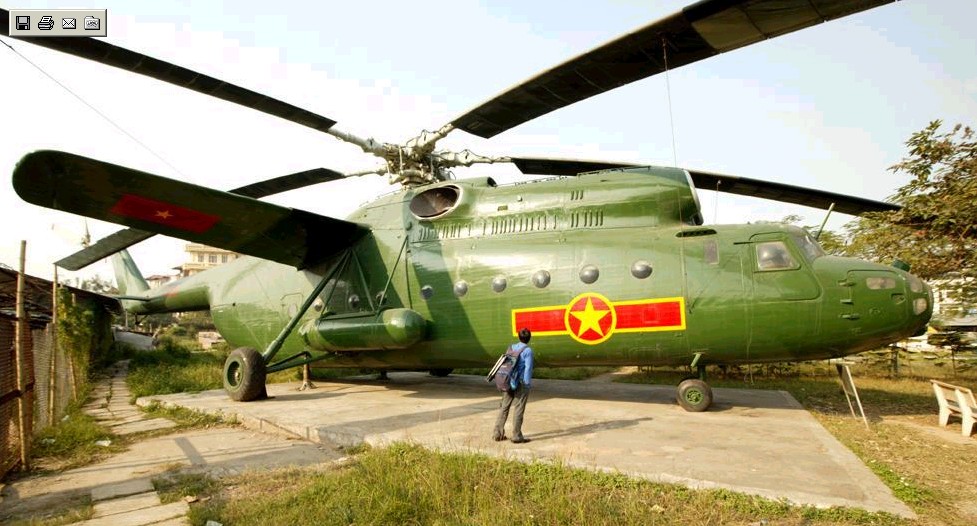
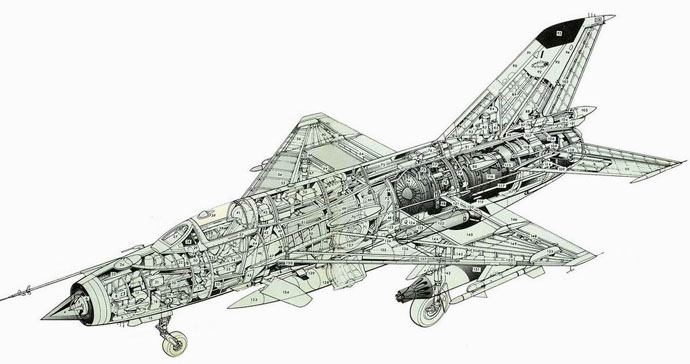
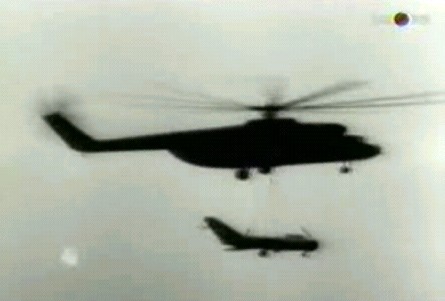
www.youtube.com/watch?v=tJKnreNpnBc
A small fighter-in-a-box (FINAB) air force could today do the same to avoid being caught on the ground and destroyed.
How will we train the New U.S. Army SkyHawk pilots?
We're glad you asked!
Advanced Training Systems International of Arizona--a PRIVATE FIRM----just happens to OWN its own A-4 Skyhawk fleet for the sole reason to train military jet pilots!
www.atsifightertraining.com/
Welcome to Advanced Training Systems International.
Advanced Training Systems International, Inc. provides customized, all-inclusive fighter combat and maintenance training programs to the armed forces of the United States and its allies worldwide.
ATSI's programs include tactical "Red Air" services, fighter lead-in training, advanced air combat maneuvers, ground training, weapons delivery, formation flying, electronic warfare, mission planning, radar theory and other combat tactics. Additionally, ATSI provides flight test and engineering flight services, photo chase, target tow, sensor carry and threat simulation.
Operating from one of the premier jet-training facilities in the world, located in the cultural center of the Southwestern United States, ATSI is ideally located for a superior training environment.
ATSI
6159 South Sossaman
Mesa, AZ 85212 USA
Phone: 480-792-6200
Fax: 480-988-9203
Human Resources humanresources@atsifightertraining.com
Executive Office executiveoffice@atsifightertraining.com
Maintenance maintenance@atsifightertraining.com
Flight Operations flightoperations@atsifightertraining.com
Training training@atsifightertraining.com
Marketing marketing@atsifightertraining.com
Safety and Quality Assurance safety@atsifightertraining.com
What would the Ultimate A-4 SkyHawk be like?
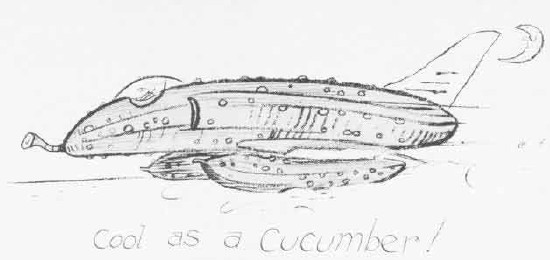
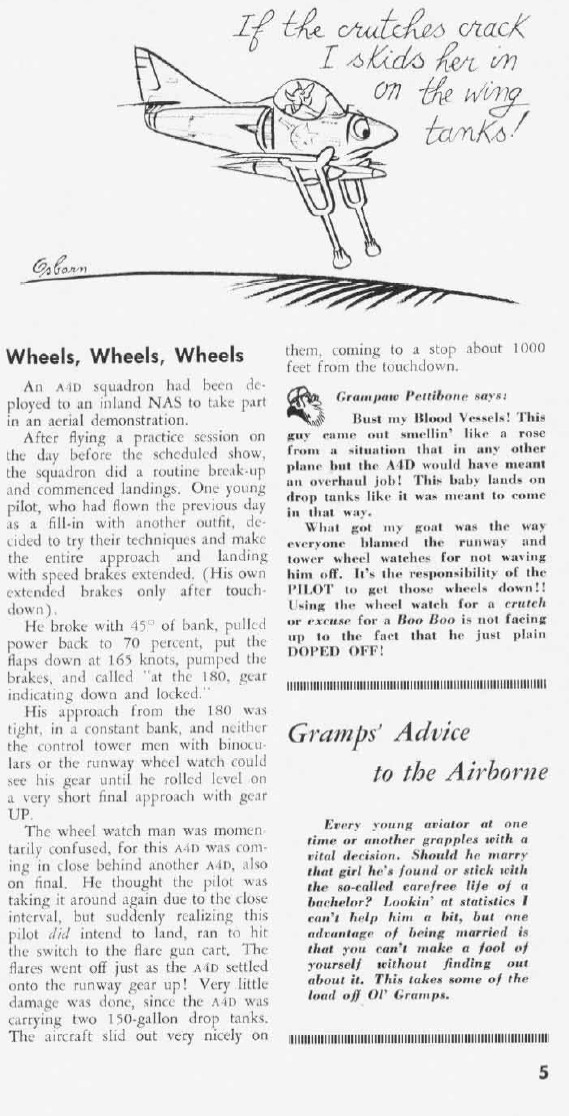
Another aspect of the SkyHawks's legendary strength is that it could often crashland on its two drop fuel tanks and suffer no damage if the pilot forgot or couldn't lower his landing gear.
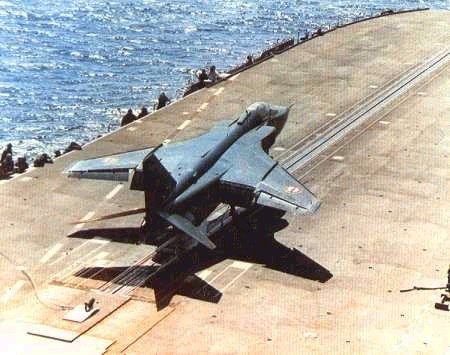
The one aspect we'd like to change is the loss of an A-4 if its engine conked out. We suggest a second or at the very least emergency turbofan engine be placed in the tail so if one engine goes out the OA-4Z would have enough power to return to base. The SEPECAT Jaguar, the T-38/F-5, and A-37 series all had twin engines that were very small that didn't result in a fat fuselage or the thrust being so widely separated that they would throw off the steering in one engine out conditions common with twins with engines on each wing. Thrust vectoring nozzles could give the new OA-4Z maneuvering capabilities akin to the SU-25 Flanker series.
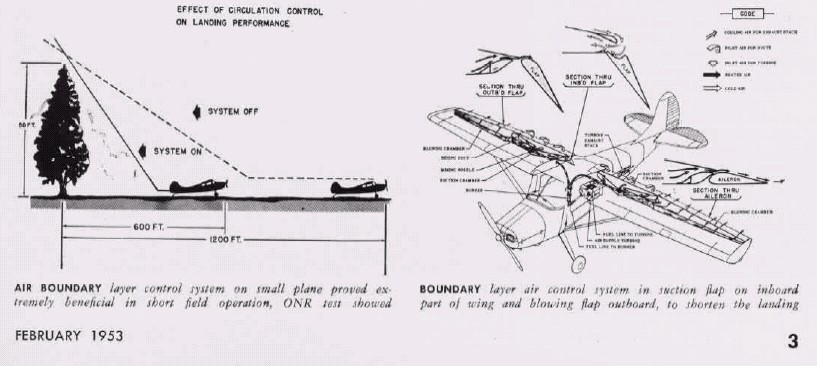
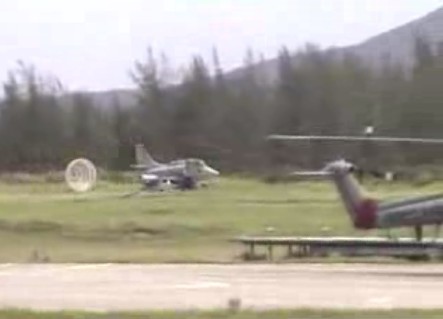
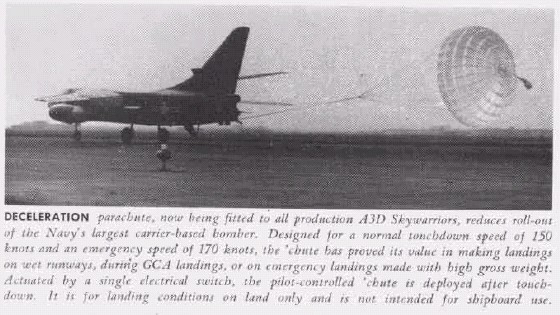
The ultimate A-4 should also have BLC for better STOL performance, a tail chute to reduce landing roll Like Brazil's A-4s have and a recovery parachute (RP) to bring the whole plane back to earth after a pilot ejects.
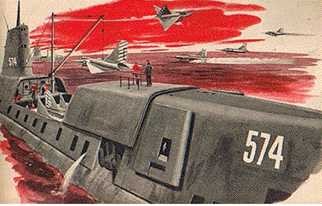
Other A-4s should float to act as submarine aircraft carrier and destroyer/cruiser/battleship seaplane fighters.
12.7mm (.50 caliber) GAU-19 and 20mm gun pods should be standard equipment on MAS SkyHawks!
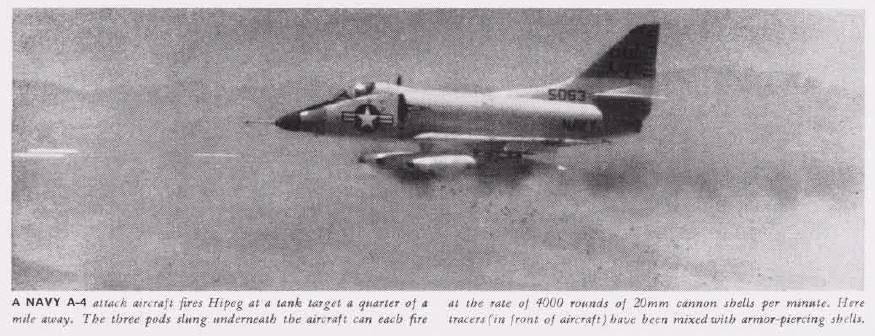
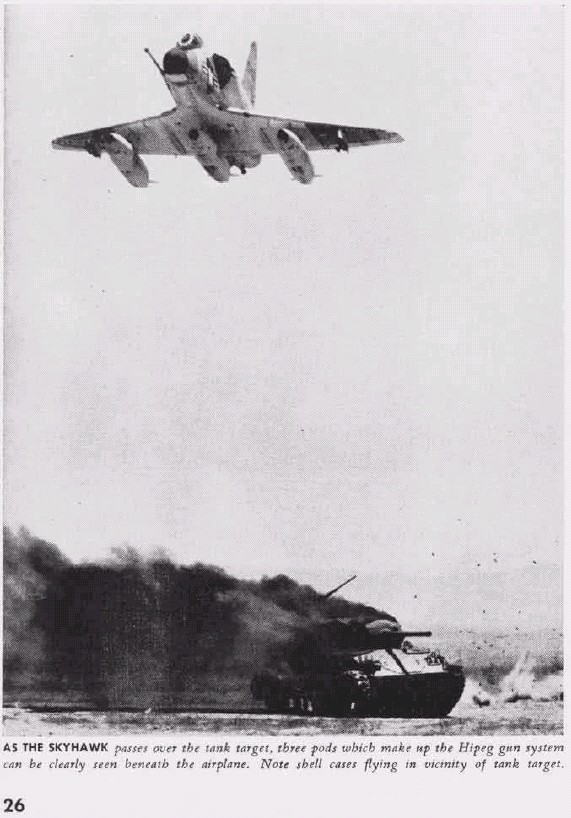
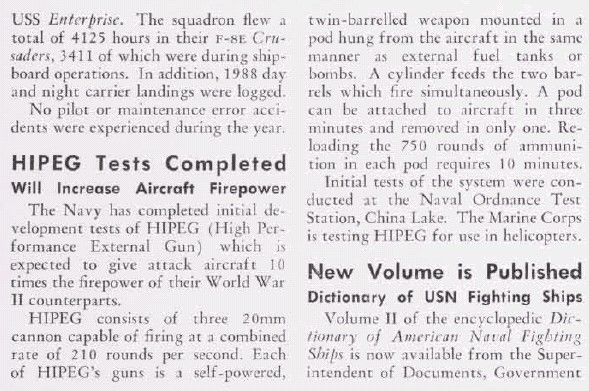
And these gun pods would be IN ADDITION TO the twin 20mm or 30mm cannon already in the A-4's wing roots!
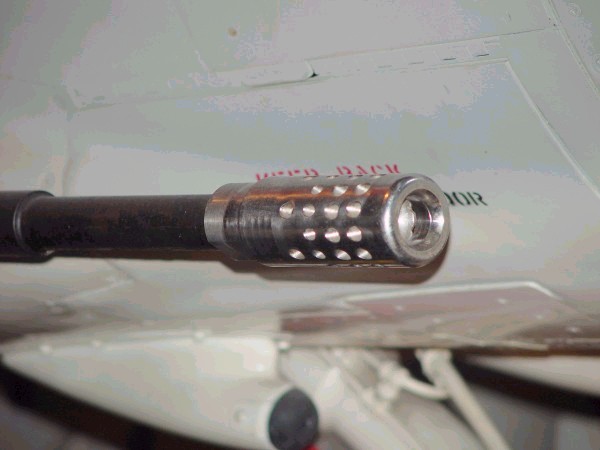
Consequenses of not keeping the A-4 SkyHawk in U.S. Service: Death Spiral Cancer in U.S. Naval Aviation Turns Malignant in 1968
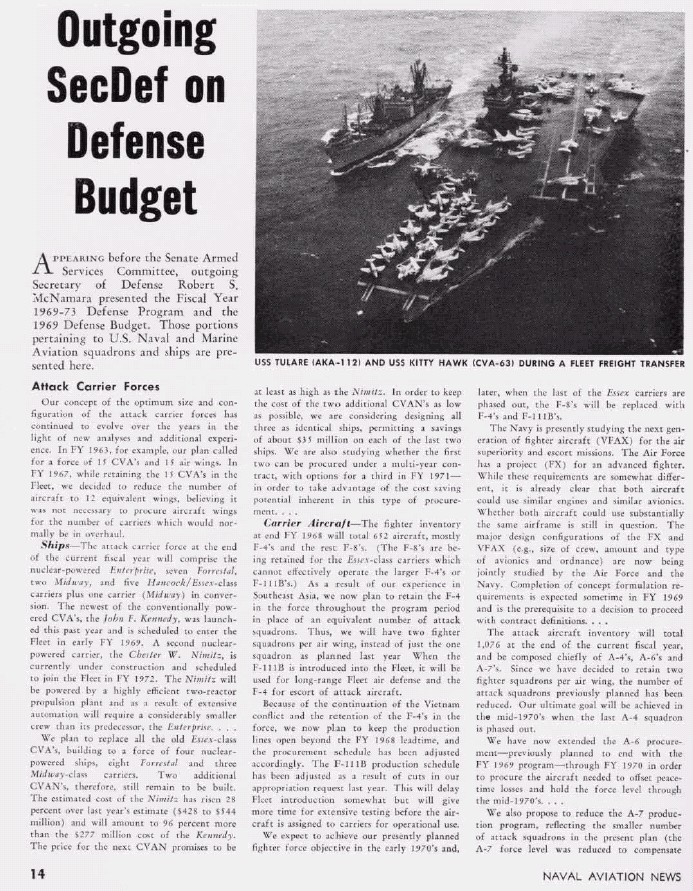
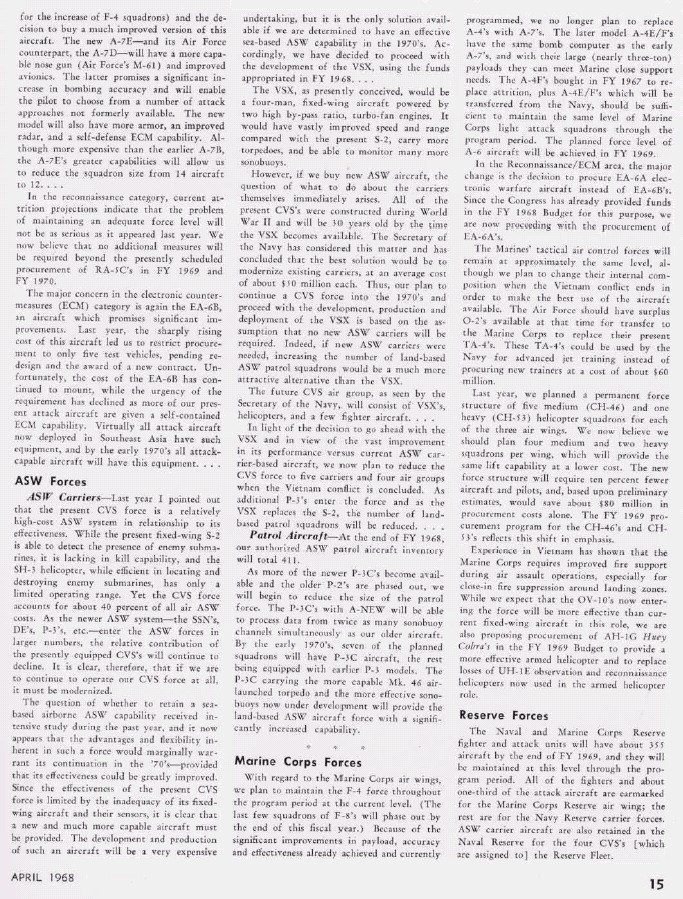
U.S. Naval Aviation began its fatal turn for the worse in 1968 when it stopped developing A-4 SkyHawks en masse in favor of handfuls of A-7 Corsair IIs with dubious slight advantages to pork feed the corrupt LBJ Texas MICC-TT "mafia" at the height of the Vietnam war. The A-4 should have been kept in production since the A-7 really offered no significant improvements. A-4s should have received at first one, then two turbofan engines to increase payload and speed to transonic. Seaplane versions would give every surface ship self-defense capability. Special submarine aircraft carriers would launch surprise air strikes and SEAL team insertion/extractions using seaplane SkyHawks and GRIER pods. Today's A-4s would have thrust vectoring and might even be stealthy. All of these things are possible by KEEPING AN AIRCRAFT TYPE IN PRODUCTION and a focus of successive improvements. The concept here of a SIMPLE, affordable aircraft to do most missions has been lost.
The other aircraft of dubious worth as part of naval aviation's "batch-itis" was the A-6 most-weather Intruder bomber. This plane shouldn't have been built, a pair of two-seat A-4 SkyHawks with night/adverse weather navaids would be cheaper and more effective than the cost of one Intruder. If we want to pork out Grumman New Yorkers and keep it going, have them build the A-4 "NightHawks" under license from Douglas/McDonnell-Douglas. One thing MacNamara did get right was to save $ and use the two-seat A-4s as pilot trainers which also keeps a two-seat AFAC capability in play which the USMC used in Vietnam to its credit.
The third strike against naval aviation after the A-7, and the A-6 was the TFX. Surprisingly as MacNamara was leaving in 1968 the delusion that the huge F-111 could be a carrier-based, fleet air defense fighter shooting BVR Phoenix AAMs was still in play. The naval F-111's cancellation represents more $ BILLIONS of wasted pork thrown the way of the corrupt Texas porksters who murdered JFK in 1963 to seize full power and plunge the nation head-long into an ill-conceived Vietnam war. If U.S. Naval Aviation finally implodes as its headed towards, you can thank former naval officers LBJ, Connally, and SecDef MacNamara and former SecNav Korth for setting them onto the final path of oblivion.
In the aftermath of Vietnam, the Navy which fought the war with WW2 Essex class large carriers and Forrestal supercarriers would be saddled with huge costs to build USS Enterprise nuclear supercarrier clones and a bunch of small aircraft batches to support. Rather than coming to their senses and building lots of affordable escort carriers from container ships and small A-4 sized planes they have spent far too much money building and operating nuclear supercarriers when the truth is they only operated ONE during the entire Vietnam war. Their excuse was that to operate the F-4 Phantoms and the TFX replacement F-14s, they would need the supercarriers; a rehash of the old we-need-the-supercarriers-to-fly-the-A-3D SkyWarriors excuse. They kept the F-8 Crusaders around adding more costs because the Essex class carriers allegedly couldn't operate the F-4s. To pay for the supercarriers in the middle of America's post-Vietnam malaise amidst hyper inflation, oil crisis etc. something would have to give--a lot of things in fact; almost like a plane with one engine out and losing altitude rapidly, the crew is tossing out the door everything they can that's not bolted to the floor in order to stay airborne!
First to go, were ASW carriers based on the Essex class, and with them the F-8s. Now ASW became a non-priority to such a degree that even the fleet was defenseless much less escorting merchant ships. It was like WW2 never happened and submarines never existed. The last gasp of the carrier-based ASW community was that the ASW helicopters were too short ranged (duhh) and the large twin-engined prop ASW planes were not fast enough, so the large turbofan twin S-3 Viking was born to operate from the supercarriers since it was a bloated design. The next things to go to pay for the supercarriers was aircraft development and maintenance on the too-many small batches of aircraft types. This gave us the "Hollow Force" of the 1970s that Admiral Zumwalt tried to correct with sea control ship mini-aircraft carriers but was rejected by the supercarrier egomaniacs resulting in the 1980 Iranian hostage rescue non-mission debacle of RH-53D minesweeping helicopters malfunctioning at Desert One and the 1983 A-7 and A-6 shoot downs over Lebanon. The F-14 Tomcats gave the pompous Navy admirals a "high-end mix" item comparable to the USAF's F-15 and a security blanket that their ego platforms wouldn't get sunk in a hail of Soviet Navy anti-ship missiles and bombs as the Brits almost had happen to them in 1982 and a 1986 sexy "Top Gun" movie to draw in naval aviator candidates, but costs were spiraling out of control. The parasitic marines whined they didn't want perfectly good A-4s anymore and demanded "new" Harriers---allegedly VTOL jump jets, crashed them all when they found out they are really STOVL and then wanted a new batch of Harrier IIs which they are finishing up crashing now. Rather than turbofan their sturdy F-4 fighter-bombers, the Navy wanted the rejected lightweight fighter program loser from Northrop to have a high-g maneuvering air-to-air fighter to join the USAF on the John Boyd bandwagon. There went the last mass-produced naval airplane and the death spiral of small batch-itis kicked in with a vengeance. A poor A-6 showing in 1991's Desert Storm resulted in that batch retired, then the A-7 batch regardless of a good showing. The Navy and marines are great liars about wanting to do CAS and the OV-10s were tossed under the bus as soon as the required excuse of a couple shoot-downs caused by IRCM neglect during the 'Storm occurred. Still not enough money saved.
Then the A-3D Skywarrior tankers were ditched. Still not enough money saved. The A-12 stealth A-6 replacement was botched so whatever was saved by retiring small batches was lost. The Navy too proud to admit it needed to use an Air Force plane refused to navalize F-117s when offered, would come to rely on USAF tankers and stealth precursor aircraft to bust a way open for them in both Iraq wars. Still running out of money, the S-3 Vikings were cancelled--to hell with ASW!, then to hell with fleet air defense!, too---F-14s "Bombcats" became "Noncats". Yet the madness for ever more nuclear supercarriers continues unabated with a "CVN-21" monstrosity on the horizon. Planes are now reduced to just increasingly gadgetized to allegedly compensate for decreasing physical power, overweight, under-powered, non-stealthy built-in-handfuls $56M each F-18s for everything and E/C-2 Hawkeyes/Greyhounds to do ash/trash and wake up everyone! We are being attacked!. That's it. Helicopters are BS good for rescuing victims which we are going to have a lot of once ANYONE challenges this stupid ever-decreasing in numbers and increasing-in-vulnerability Navy clusterfuck @ sea.
Had the Navy not taken a turn for the worse in 1968, and kept operating and buying "low-end mix" A-4s we could have had a trainer plane with an attack capability, too instead of the T-45 Goshawk which only trains and represents more $ down the drain. More money will soon be wasted keeping up with the Air Force "Joneses" buying T-6A Texan II trainers to replace still perfectly good T-34C Turbo Mentor turboprops that just need ejection or extraction seats or recovery parachutes and could be great AFAC planes to do MAS had the Navy or Mc been interested in such things.
All hopes are now on the F-35B/C Lightning II Joint Strike Fighter which research suggests will be an AOK interdiction land attack plane but a deficient in stealth fighter plane to have a significant edge in air-to-air combat against the SU-25 Flanker series which has thrust vectoring super maneuvering and BVR AAMs that can after launch in the general direction of our F-18s/F-35B/Cs and acquire these targets while-in-flight once they are forced to maneuver to break lock.
If the F-35 falters, pundits proclaim the unmanned airplane full of gadgets will fill our supercarriers while constantly crashing at a 50% rate; we are our own kamikazes. So corporate greed has went from small batches of manned aircraft in the '50s/'60s to cramming electronic black box gadgets into ever decreasing numbers of physical manned platforms in the '70s/'80s to the current lets-not-build-any-airplanes lets cram gadgets into even less physical amounts of material to maximize our profits in the '90s.
REFERENCES
A-4 Skyhawks @ Davis-Monthan AMARC
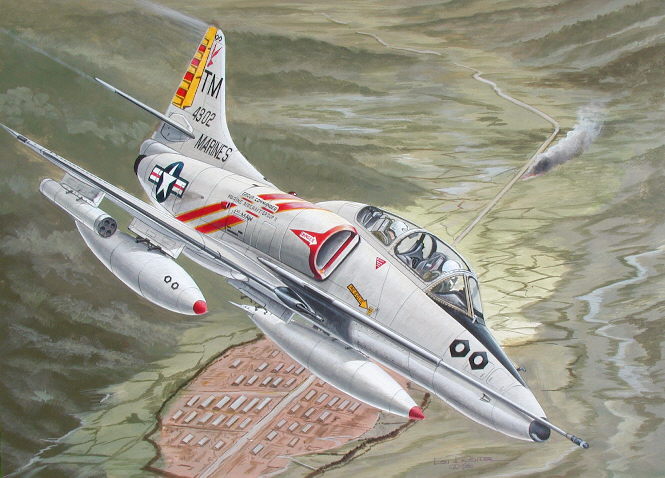
THE GREAT A-4 DESIGNER SPEAKS!
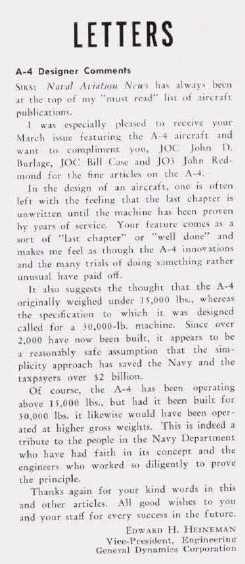
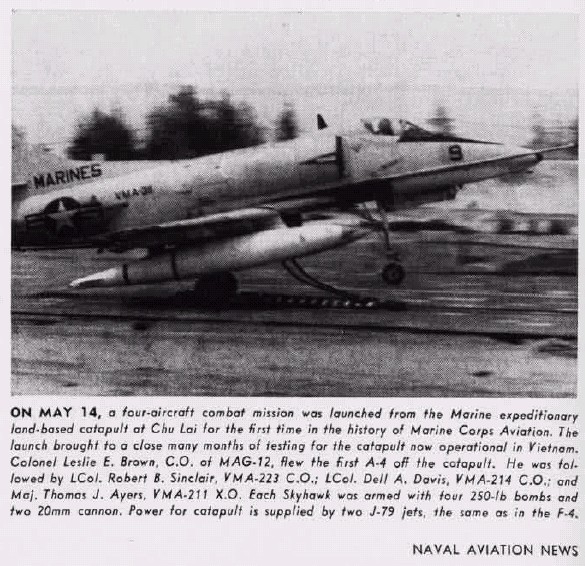
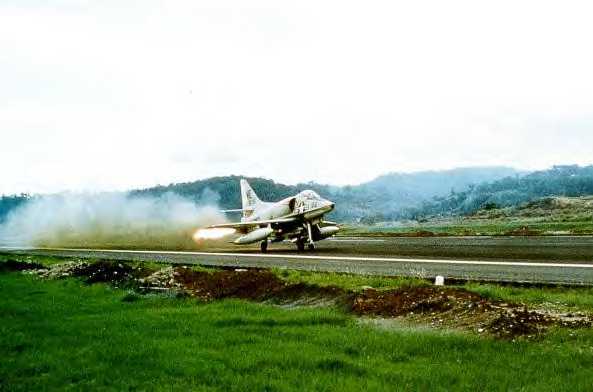
http://216.239.51.104/search?q=cache:_OLypVByzSkJ:www.skyhawk.org/4E/mag13/hms13.htm+a-4s+army+skyhawk&hl=en&ie=UTF-8
A second airfield was sorely needed. Chu Lai located about 50 miles south of Da Nang was chosen for the new airfield. Navy Seabees worked in 100-degree-plus temperatures to prepare the remote Chu Lai site for an aluminum plank SATS (short airfield for tactical support) "tinfoil strip" 4,000-foot runway. A catapult and arresting gear were planned to allow Skyhawks to use the field. The arresting gear was soon installed but a catapult was not available. So JATO (Jet Assisted Take Off) was planned to reduce the Skyhawk takeoff distance by half. Soon the Chu Lai facility had a runway, arresting gear, taxiways, and a parking ramp. A catapult was installed May 14, 1966.
OA-4M Details
An OA-4M Skyhawk from MAG-12 taxis on the flight line during the combined Thai/U.S. joint Exercise Thalay Thai `89, 1 September 1989. U.S. Navy photo by PH1 Flynn.
The designation OA-4M was assigned to 23 TA-4Fs that were reworked at NAS Pensacola to act as fast forward air controller aircraft for the Marine Corps. The OA-4M was basically a TA-4F equipped with the electronics of the A-4M, the main U.S. marine Corps close support aircraft
The modifications included a ground control bombing system, a KY-28 secure voice system, a canted midair refuelling probe, extra cockpit side armor plating, an APN-194 altimeter, and ARC-159 radio and ARC-114 VHF radio. Perhaps the most visible change was the fitting of the dorsal electronics hump, neatly faired into the rear of the two-seat canopy. The nose sensor group of the OA-4M was basically the same as that of the A-4M, but the Angle/Rate Bombing system was not fitted, and the laser spotting and tracking window was faired over, since neither of these were needed on an aircraft which was not to be employed in a pure bombing role.
Some consideration was given to fitting the 11,200 lbs. thrust Pratt & Whitney J52-P-408 of the A-4M, but this turned out to be impractical, and the OA-4M retained the J52-P-8 of the TA-4F.
The first OA-4M, BuNo 165294 was tested at NATC Patuxent River, MD in July of 1978. The first squadron to receive the OA-4M was H&MS-52, based at MCAS Cherry Point, NC.
Sources
Naval Historical Center Joseph Baugher
Last Revised July 6, 2003
OA-4M Flight Manual
www.eflightmanuals.com/detail/itemList.asp?CategoryGroupID=6
